
Shareholder Letter Q2 2023
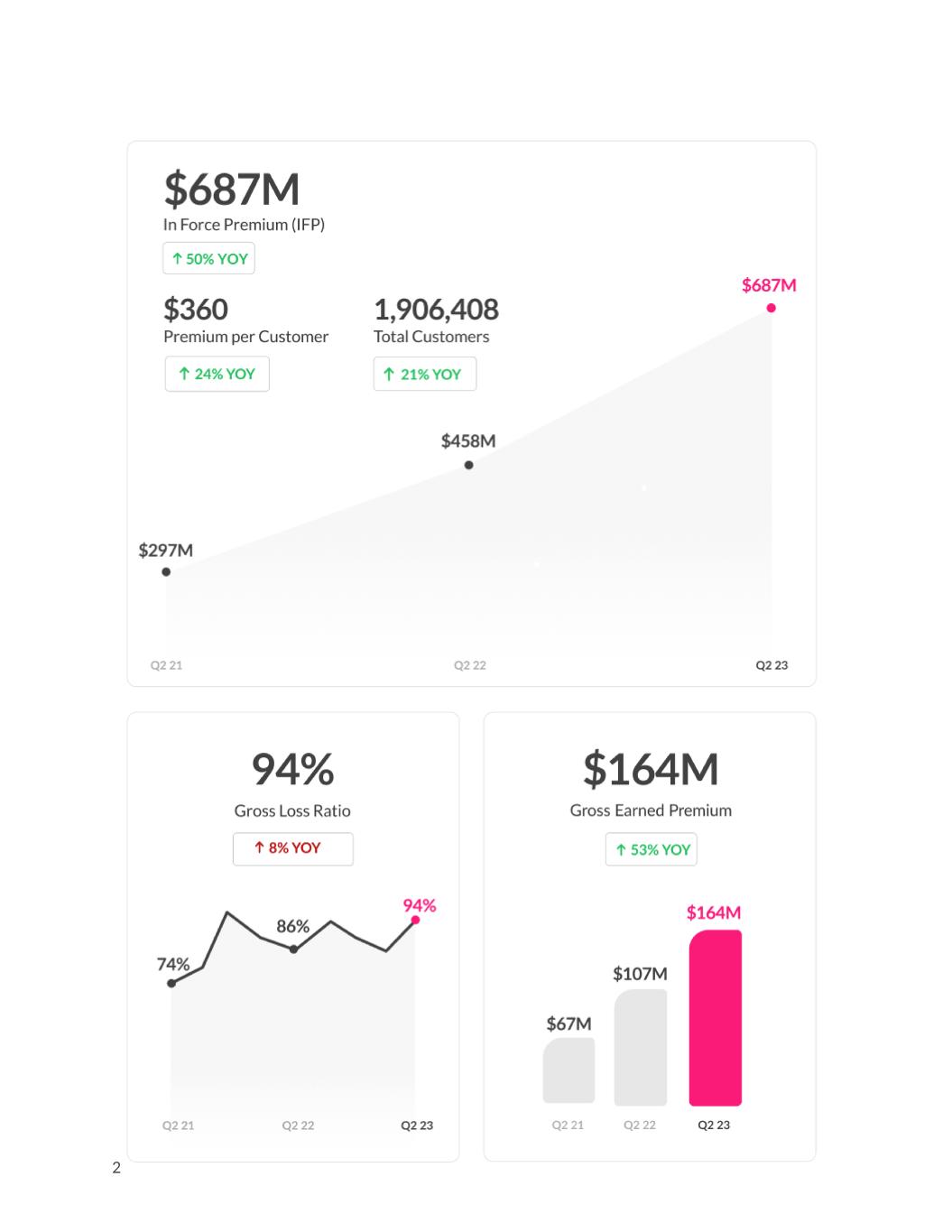
2
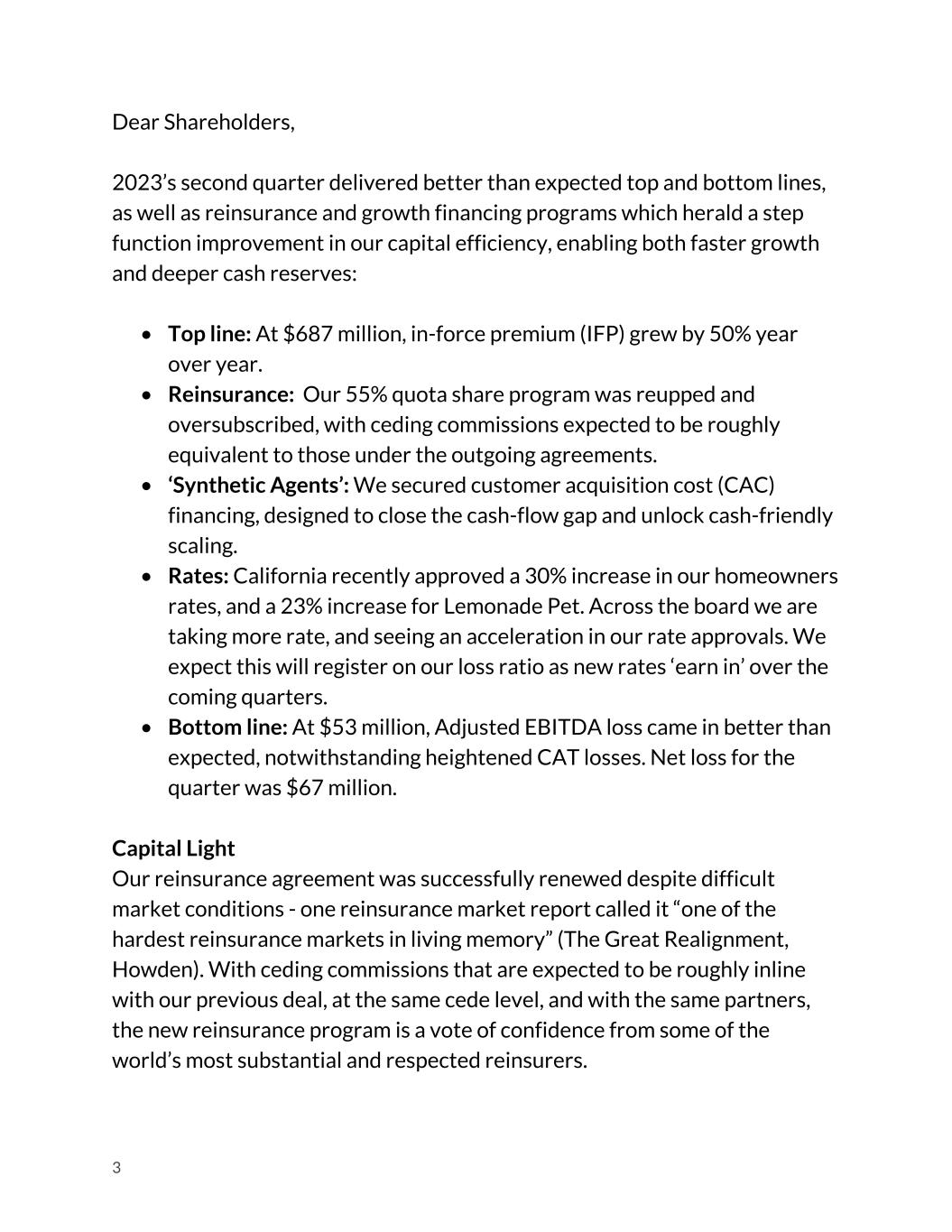
Dear Shareholders, 2023’s second quarter delivered better than expected top and bottom lines, as well as reinsurance and growth financing programs which herald a step function improvement in our capital efficiency, enabling both faster growth and deeper cash reserves: • Top line: At $687 million, in-force premium (IFP) grew by 50% year over year. • Reinsurance: Our 55% quota share program was reupped and oversubscribed, with ceding commissions expected to be roughly equivalent to those under the outgoing agreements. • ‘Synthetic Agents’: We secured customer acquisition cost (CAC) financing, designed to close the cash-flow gap and unlock cash-friendly scaling. • Rates: California recently approved a 30% increase in our homeowners rates, and a 23% increase for Lemonade Pet. Across the board we are taking more rate, and seeing an acceleration in our rate approvals. We expect this will register on our loss ratio as new rates ‘earn in’ over the coming quarters. • Bottom line: At $53 million, Adjusted EBITDA loss came in better than expected, notwithstanding heightened CAT losses. Net loss for the quarter was $67 million. Capital Light Our reinsurance agreement was successfully renewed despite difficult market conditions - one reinsurance market report called it “one of the hardest reinsurance markets in living memory” (The Great Realignment, Howden). With ceding commissions that are expected to be roughly inline with our previous deal, at the same cede level, and with the same partners, the new reinsurance program is a vote of confidence from some of the world’s most substantial and respected reinsurers. 3
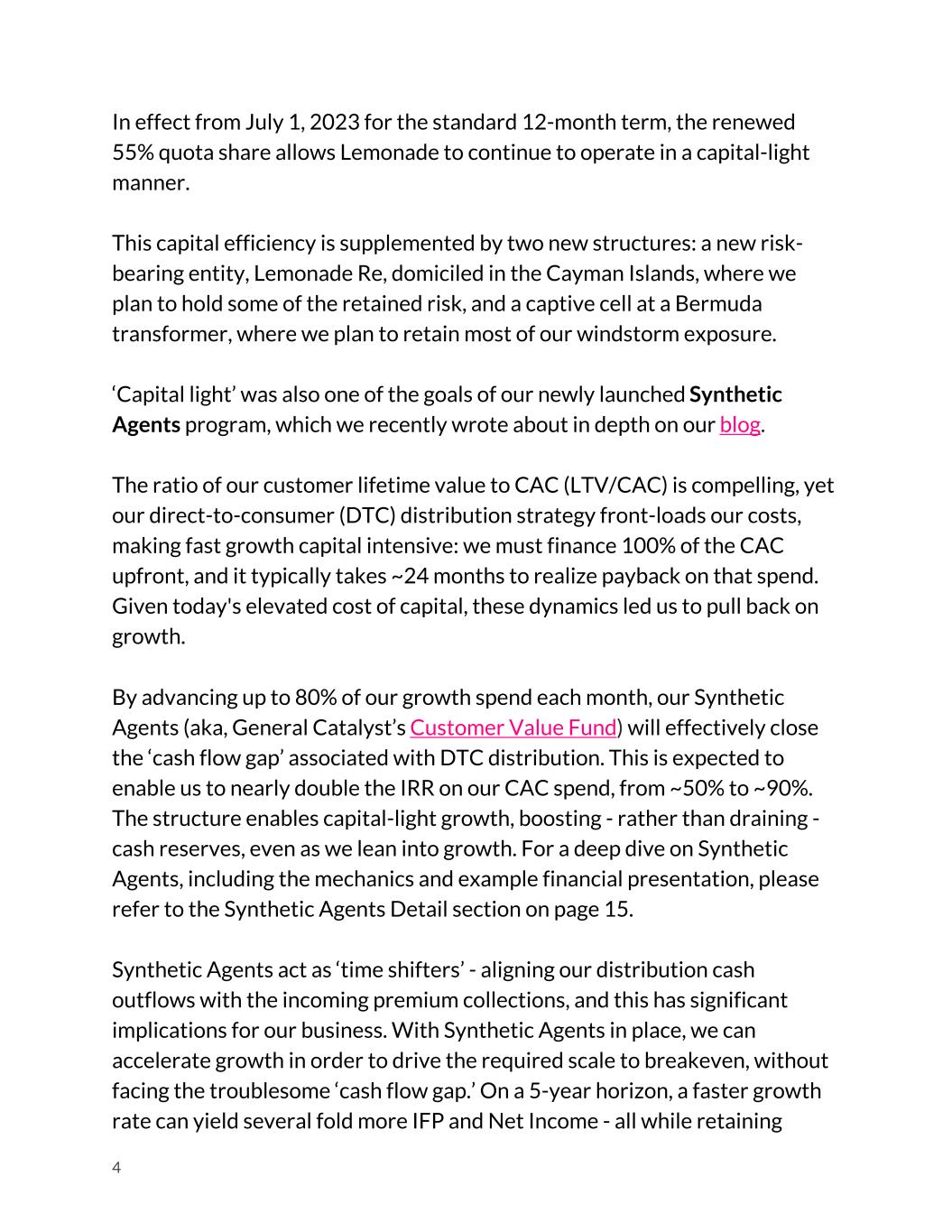
In effect from July 1, 2023 for the standard 12-month term, the renewed 55% quota share allows Lemonade to continue to operate in a capital-light manner. This capital efficiency is supplemented by two new structures: a new risk- bearing entity, Lemonade Re, domiciled in the Cayman Islands, where we plan to hold some of the retained risk, and a captive cell at a Bermuda transformer, where we plan to retain most of our windstorm exposure. ‘Capital light’ was also one of the goals of our newly launched Synthetic Agents program, which we recently wrote about in depth on our blog. The ratio of our customer lifetime value to CAC (LTV/CAC) is compelling, yet our direct-to-consumer (DTC) distribution strategy front-loads our costs, making fast growth capital intensive: we must finance 100% of the CAC upfront, and it typically takes ~24 months to realize payback on that spend. Given today's elevated cost of capital, these dynamics led us to pull back on growth. By advancing up to 80% of our growth spend each month, our Synthetic Agents (aka, General Catalyst’s Customer Value Fund) will effectively close the ‘cash flow gap’ associated with DTC distribution. This is expected to enable us to nearly double the IRR on our CAC spend, from ~50% to ~90%. The structure enables capital-light growth, boosting - rather than draining - cash reserves, even as we lean into growth. For a deep dive on Synthetic Agents, including the mechanics and example financial presentation, please refer to the Synthetic Agents Detail section on page 15. Synthetic Agents act as ‘time shifters’ - aligning our distribution cash outflows with the incoming premium collections, and this has significant implications for our business. With Synthetic Agents in place, we can accelerate growth in order to drive the required scale to breakeven, without facing the troublesome ‘cash flow gap.’ On a 5-year horizon, a faster growth rate can yield several fold more IFP and Net Income - all while retaining 4
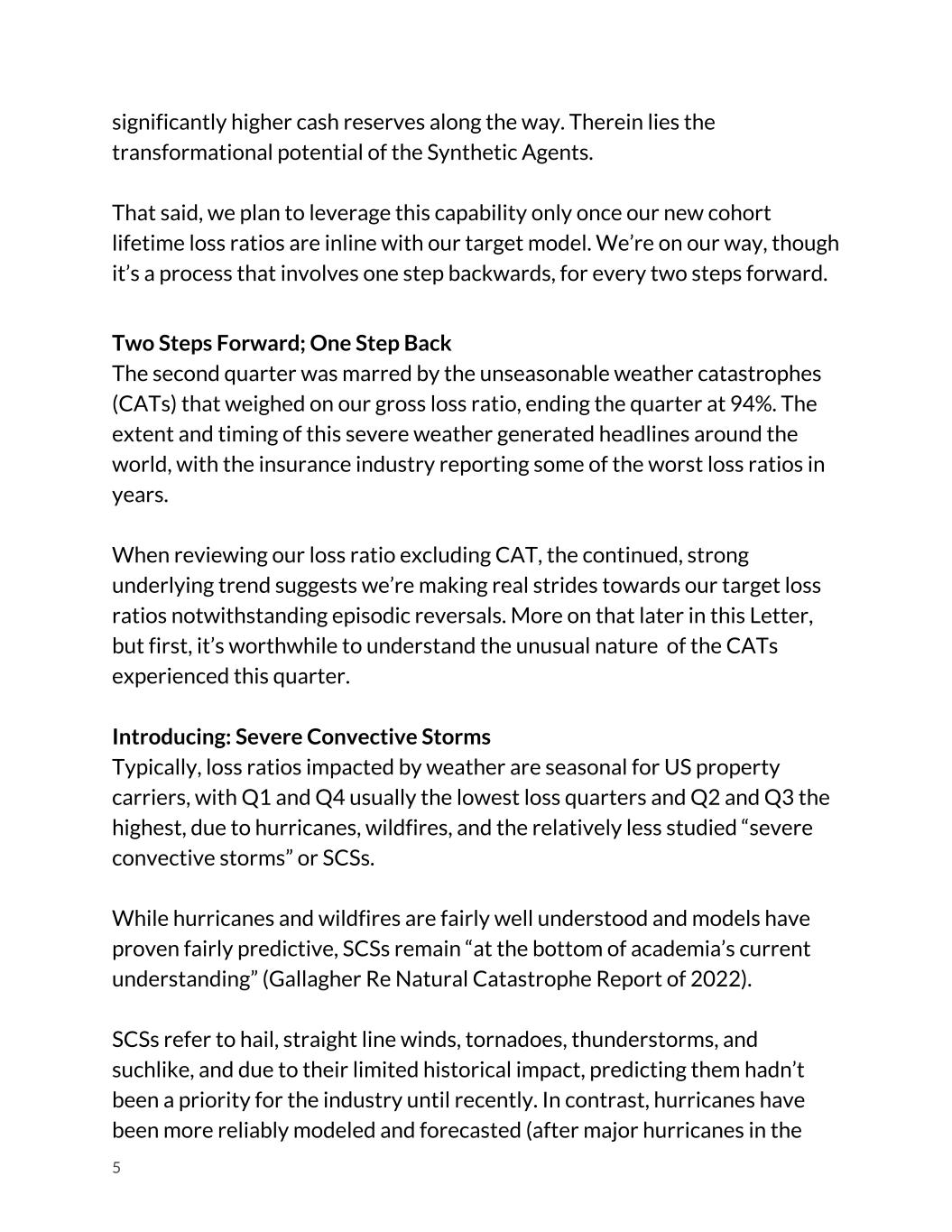
significantly higher cash reserves along the way. Therein lies the transformational potential of the Synthetic Agents. That said, we plan to leverage this capability only once our new cohort lifetime loss ratios are inline with our target model. We’re on our way, though it’s a process that involves one step backwards, for every two steps forward. Two Steps Forward; One Step Back The second quarter was marred by the unseasonable weather catastrophes (CATs) that weighed on our gross loss ratio, ending the quarter at 94%. The extent and timing of this severe weather generated headlines around the world, with the insurance industry reporting some of the worst loss ratios in years. When reviewing our loss ratio excluding CAT, the continued, strong underlying trend suggests we’re making real strides towards our target loss ratios notwithstanding episodic reversals. More on that later in this Letter, but first, it’s worthwhile to understand the unusual nature of the CATs experienced this quarter. Introducing: Severe Convective Storms Typically, loss ratios impacted by weather are seasonal for US property carriers, with Q1 and Q4 usually the lowest loss quarters and Q2 and Q3 the highest, due to hurricanes, wildfires, and the relatively less studied “severe convective storms” or SCSs. While hurricanes and wildfires are fairly well understood and models have proven fairly predictive, SCSs remain “at the bottom of academia’s current understanding” (Gallagher Re Natural Catastrophe Report of 2022). SCSs refer to hail, straight line winds, tornadoes, thunderstorms, and suchlike, and due to their limited historical impact, predicting them hadn’t been a priority for the industry until recently. In contrast, hurricanes have been more reliably modeled and forecasted (after major hurricanes in the 5
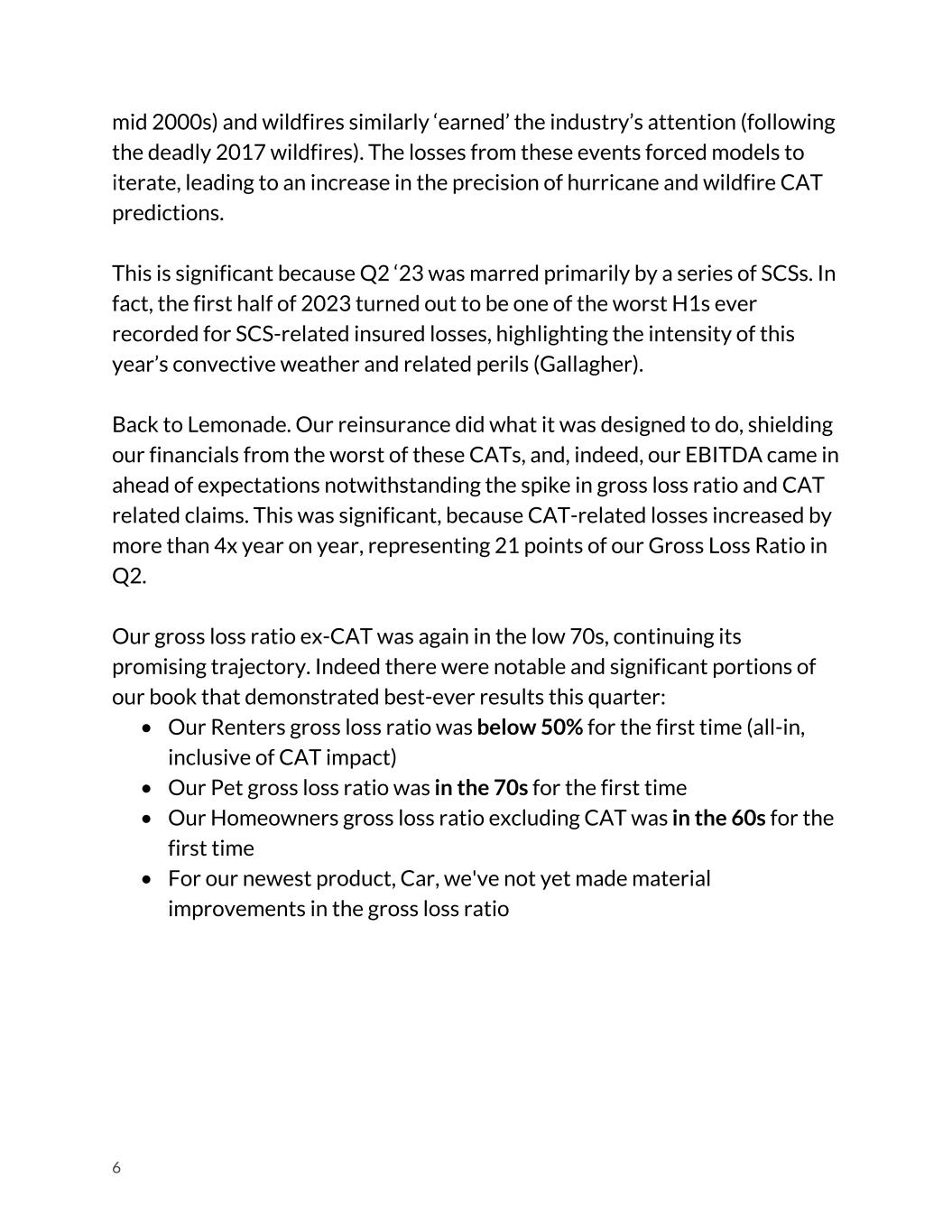
mid 2000s) and wildfires similarly ‘earned’ the industry’s attention (following the deadly 2017 wildfires). The losses from these events forced models to iterate, leading to an increase in the precision of hurricane and wildfire CAT predictions. This is significant because Q2 ‘23 was marred primarily by a series of SCSs. In fact, the first half of 2023 turned out to be one of the worst H1s ever recorded for SCS-related insured losses, highlighting the intensity of this year’s convective weather and related perils (Gallagher). Back to Lemonade. Our reinsurance did what it was designed to do, shielding our financials from the worst of these CATs, and, indeed, our EBITDA came in ahead of expectations notwithstanding the spike in gross loss ratio and CAT related claims. This was significant, because CAT-related losses increased by more than 4x year on year, representing 21 points of our Gross Loss Ratio in Q2. Our gross loss ratio ex-CAT was again in the low 70s, continuing its promising trajectory. Indeed there were notable and significant portions of our book that demonstrated best-ever results this quarter: • Our Renters gross loss ratio was below 50% for the first time (all-in, inclusive of CAT impact) • Our Pet gross loss ratio was in the 70s for the first time • Our Homeowners gross loss ratio excluding CAT was in the 60s for the first time • For our newest product, Car, we've not yet made material improvements in the gross loss ratio 6
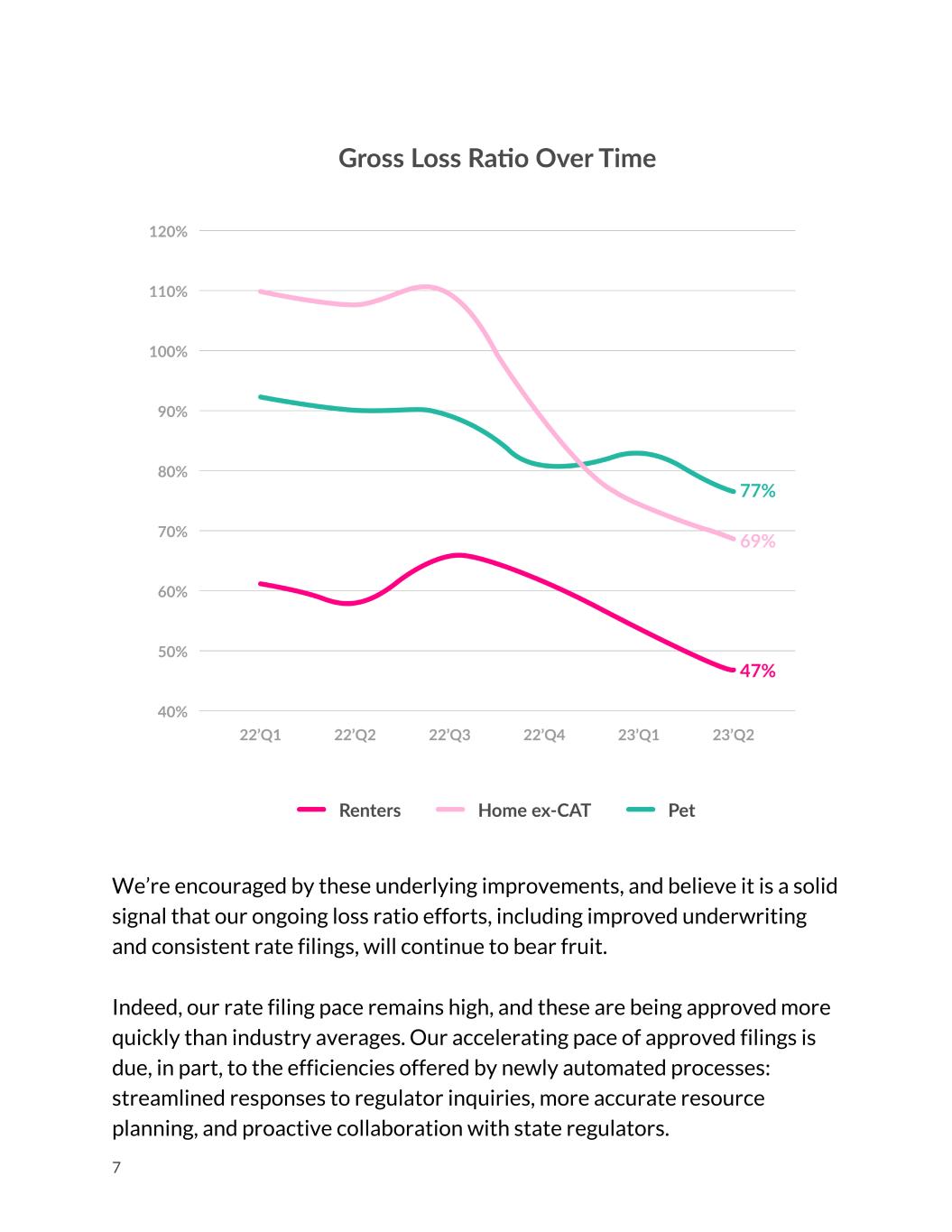
We’re encouraged by these underlying improvements, and believe it is a solid signal that our ongoing loss ratio efforts, including improved underwriting and consistent rate filings, will continue to bear fruit. Indeed, our rate filing pace remains high, and these are being approved more quickly than industry averages. Our accelerating pace of approved filings is due, in part, to the efficiencies offered by newly automated processes: streamlined responses to regulator inquiries, more accurate resource planning, and proactive collaboration with state regulators. 7
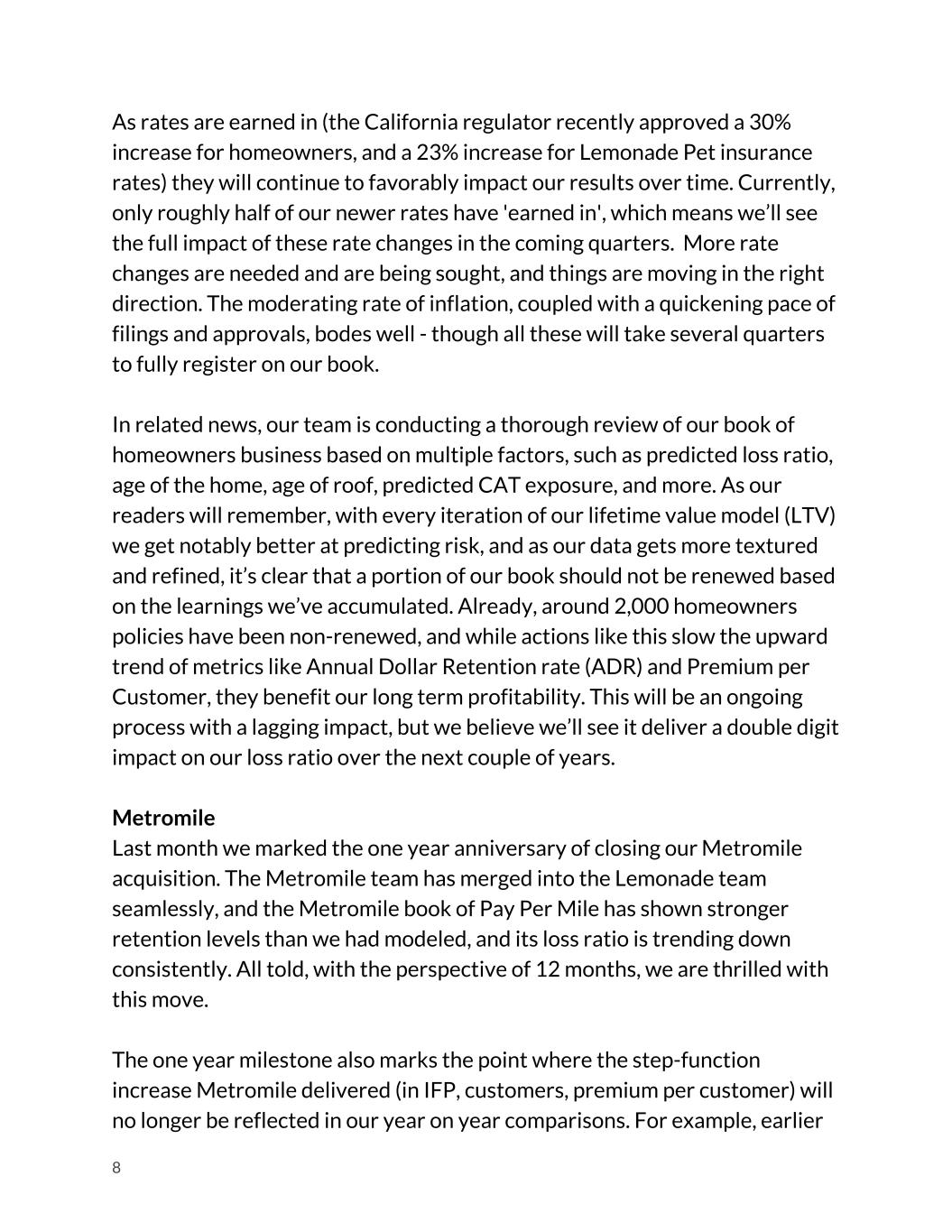
As rates are earned in (the California regulator recently approved a 30% increase for homeowners, and a 23% increase for Lemonade Pet insurance rates) they will continue to favorably impact our results over time. Currently, only roughly half of our newer rates have 'earned in', which means we’ll see the full impact of these rate changes in the coming quarters. More rate changes are needed and are being sought, and things are moving in the right direction. The moderating rate of inflation, coupled with a quickening pace of filings and approvals, bodes well - though all these will take several quarters to fully register on our book. In related news, our team is conducting a thorough review of our book of homeowners business based on multiple factors, such as predicted loss ratio, age of the home, age of roof, predicted CAT exposure, and more. As our readers will remember, with every iteration of our lifetime value model (LTV) we get notably better at predicting risk, and as our data gets more textured and refined, it’s clear that a portion of our book should not be renewed based on the learnings we’ve accumulated. Already, around 2,000 homeowners policies have been non-renewed, and while actions like this slow the upward trend of metrics like Annual Dollar Retention rate (ADR) and Premium per Customer, they benefit our long term profitability. This will be an ongoing process with a lagging impact, but we believe we’ll see it deliver a double digit impact on our loss ratio over the next couple of years. Metromile Last month we marked the one year anniversary of closing our Metromile acquisition. The Metromile team has merged into the Lemonade team seamlessly, and the Metromile book of Pay Per Mile has shown stronger retention levels than we had modeled, and its loss ratio is trending down consistently. All told, with the perspective of 12 months, we are thrilled with this move. The one year milestone also marks the point where the step-function increase Metromile delivered (in IFP, customers, premium per customer) will no longer be reflected in our year on year comparisons. For example, earlier 8
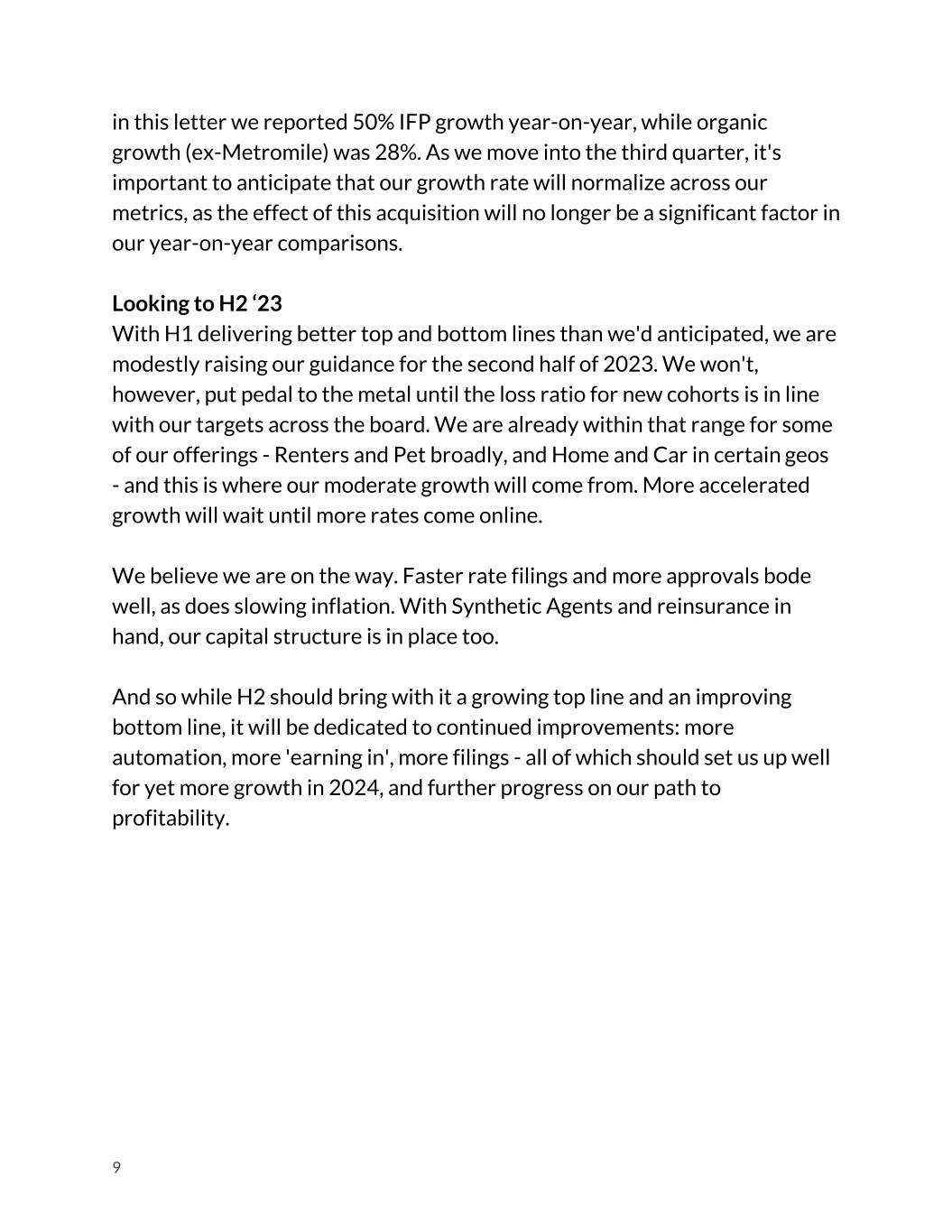
in this letter we reported 50% IFP growth year-on-year, while organic growth (ex-Metromile) was 28%. As we move into the third quarter, it's important to anticipate that our growth rate will normalize across our metrics, as the effect of this acquisition will no longer be a significant factor in our year-on-year comparisons. Looking to H2 ‘23 With H1 delivering better top and bottom lines than we'd anticipated, we are modestly raising our guidance for the second half of 2023. We won't, however, put pedal to the metal until the loss ratio for new cohorts is in line with our targets across the board. We are already within that range for some of our offerings - Renters and Pet broadly, and Home and Car in certain geos - and this is where our moderate growth will come from. More accelerated growth will wait until more rates come online. We believe we are on the way. Faster rate filings and more approvals bode well, as does slowing inflation. With Synthetic Agents and reinsurance in hand, our capital structure is in place too. And so while H2 should bring with it a growing top line and an improving bottom line, it will be dedicated to continued improvements: more automation, more 'earning in', more filings - all of which should set us up well for yet more growth in 2024, and further progress on our path to profitability. 9
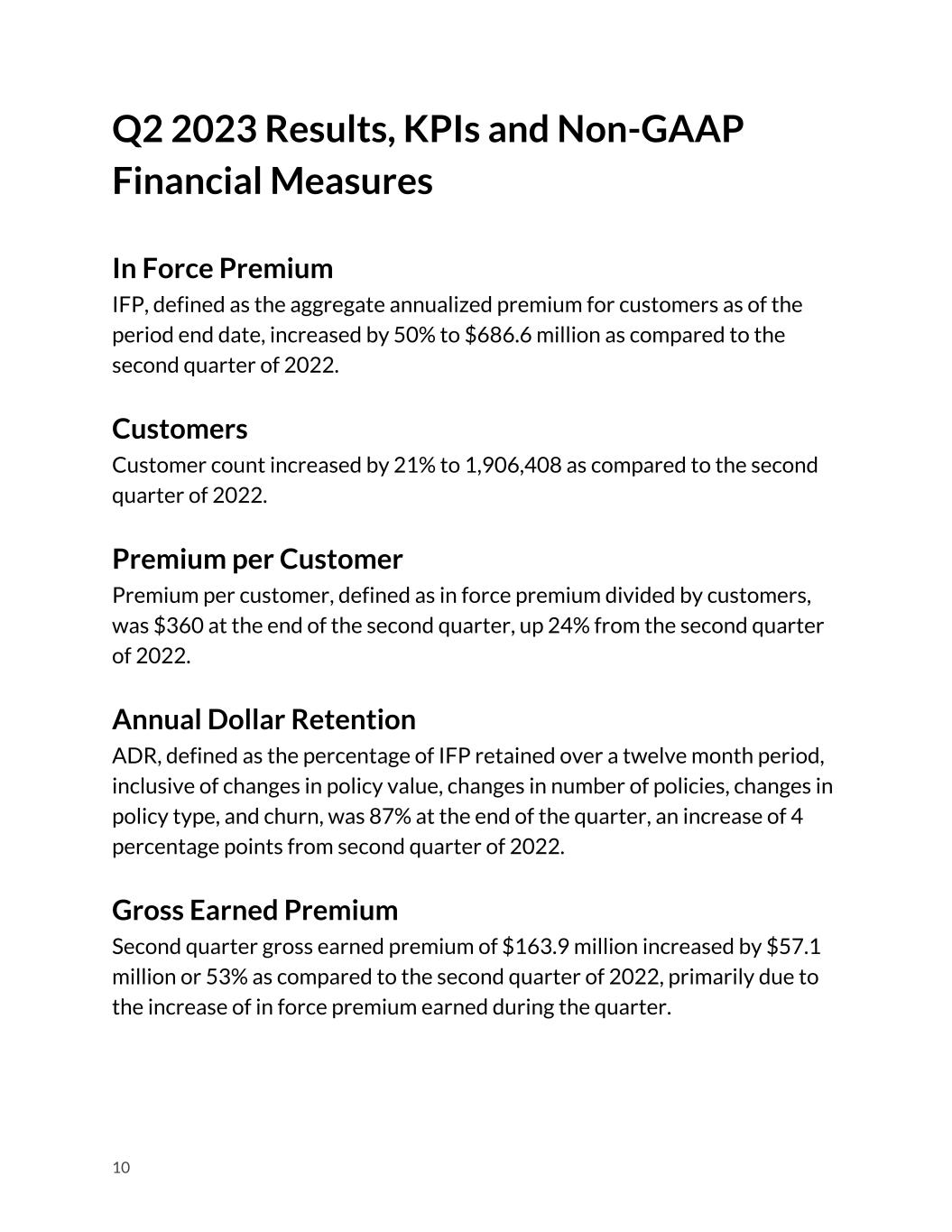
Q2 2023 Results, KPIs and Non-GAAP Financial Measures In Force Premium IFP, defined as the aggregate annualized premium for customers as of the period end date, increased by 50% to $686.6 million as compared to the second quarter of 2022. Customers Customer count increased by 21% to 1,906,408 as compared to the second quarter of 2022. Premium per Customer Premium per customer, defined as in force premium divided by customers, was $360 at the end of the second quarter, up 24% from the second quarter of 2022. Annual Dollar Retention ADR, defined as the percentage of IFP retained over a twelve month period, inclusive of changes in policy value, changes in number of policies, changes in policy type, and churn, was 87% at the end of the quarter, an increase of 4 percentage points from second quarter of 2022. Gross Earned Premium Second quarter gross earned premium of $163.9 million increased by $57.1 million or 53% as compared to the second quarter of 2022, primarily due to the increase of in force premium earned during the quarter. 10

Revenue Second quarter revenue of $104.6 million increased by $54.6 million or 109% as compared to the second quarter of 2022, primarily due to the increase of gross earned premium during the quarter, and to a lesser extent, a reduction in the proportion of earned premium ceded to reinsurers. Gross Profit Second quarter gross profit of $12.1 million increased by $0.8 million or 7% as compared to the second quarter of 2022, primarily due to higher earned premium, offset by a higher loss ratio in the second quarter this year. Adjusted Gross Profit Second quarter adjusted gross profit of $16.6 million decreased by $0.9 million or 5% as compared to the second quarter of 2022, primarily due to the higher loss ratio in the second quarter. Adjusted gross profit is a non-GAAP metric. Reconciliations of GAAP to non- GAAP financial measures, as well as definitions for the non-GAAP financial measures included in this letter and the reasons for their use, are presented at the end of this letter. Operating Expense Total operating expense, excluding net loss and loss adjustment expense, in the second quarter increased by $7.7 million to $94.6 million as compared to $86.9 million in the second quarter of 2022. The modest year-over-year increase was primarily driven by the addition of the Metromile expense base not included in the prior year figure, partially offset by lower growth spend. Net Loss Net loss in second quarter was $67.2 million, or $(0.97) per share, as compared to $67.9 million, or $(1.10) per share, in the second quarter of 2022. 11
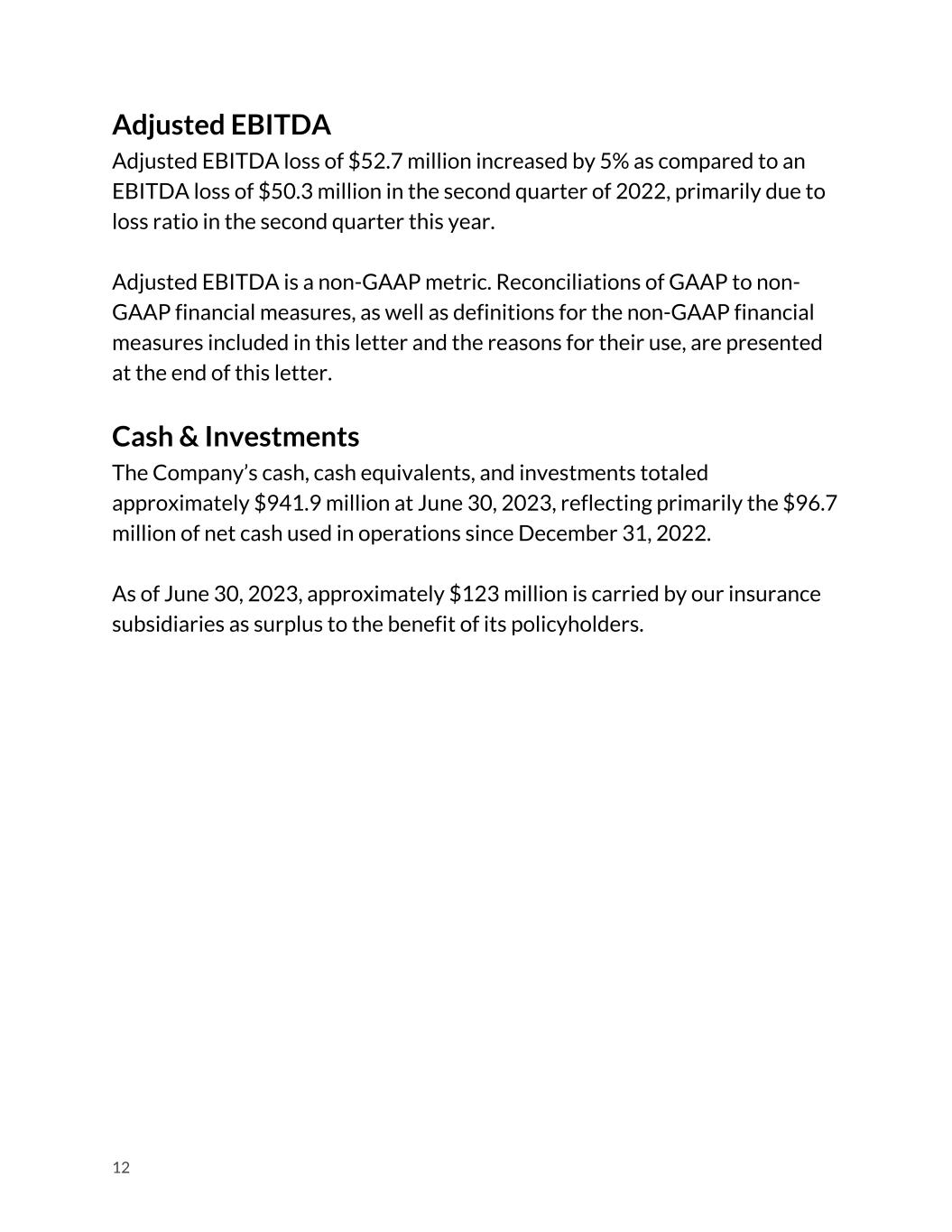
Adjusted EBITDA Adjusted EBITDA loss of $52.7 million increased by 5% as compared to an EBITDA loss of $50.3 million in the second quarter of 2022, primarily due to loss ratio in the second quarter this year. Adjusted EBITDA is a non-GAAP metric. Reconciliations of GAAP to non- GAAP financial measures, as well as definitions for the non-GAAP financial measures included in this letter and the reasons for their use, are presented at the end of this letter. Cash & Investments The Company’s cash, cash equivalents, and investments totaled approximately $941.9 million at June 30, 2023, reflecting primarily the $96.7 million of net cash used in operations since December 31, 2022. As of June 30, 2023, approximately $123 million is carried by our insurance subsidiaries as surplus to the benefit of its policyholders. 12
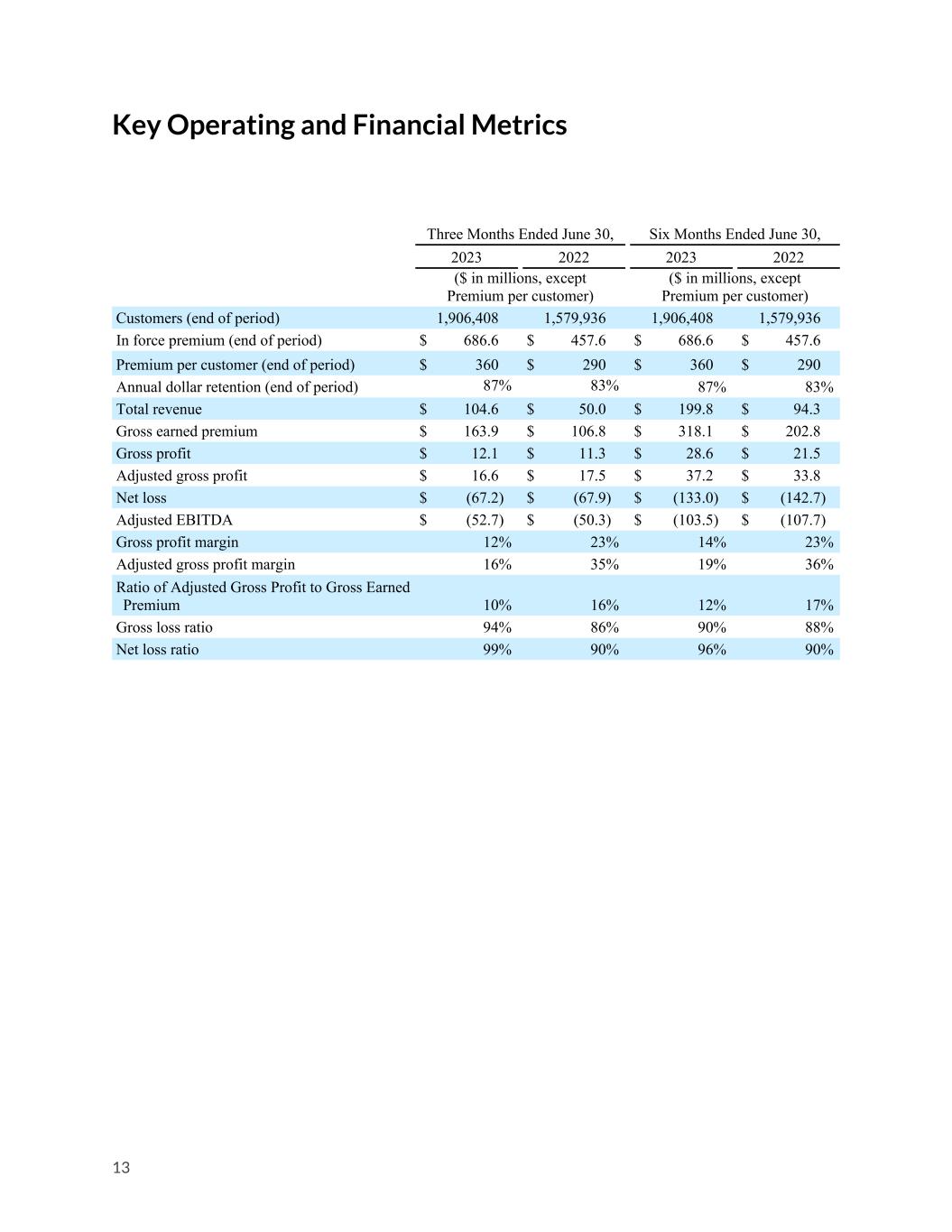
Key Operating and Financial Metrics Three Months Ended June 30, Six Months Ended June 30, 2023 2022 2023 2022 ($ in millions, except Premium per customer) ($ in millions, except Premium per customer) Customers (end of period) 1,906,408 1,579,936 1,906,408 1,579,936 In force premium (end of period) $ 686.6 $ 457.6 $ 686.6 $ 457.6 Premium per customer (end of period) $ 360 $ 290 $ 360 $ 290 Annual dollar retention (end of period) 87% 83% 87% 83% Total revenue $ 104.6 $ 50.0 $ 199.8 $ 94.3 Gross earned premium $ 163.9 $ 106.8 $ 318.1 $ 202.8 Gross profit $ 12.1 $ 11.3 $ 28.6 $ 21.5 Adjusted gross profit $ 16.6 $ 17.5 $ 37.2 $ 33.8 Net loss $ (67.2) $ (67.9) $ (133.0) $ (142.7) Adjusted EBITDA $ (52.7) $ (50.3) $ (103.5) $ (107.7) Gross profit margin 12% 23% 14% 23% Adjusted gross profit margin 16% 35% 19% 36% Ratio of Adjusted Gross Profit to Gross Earned Premium 10% 16% 12% 17% Gross loss ratio 94% 86% 90% 88% Net loss ratio 99% 90% 96% 90% 13
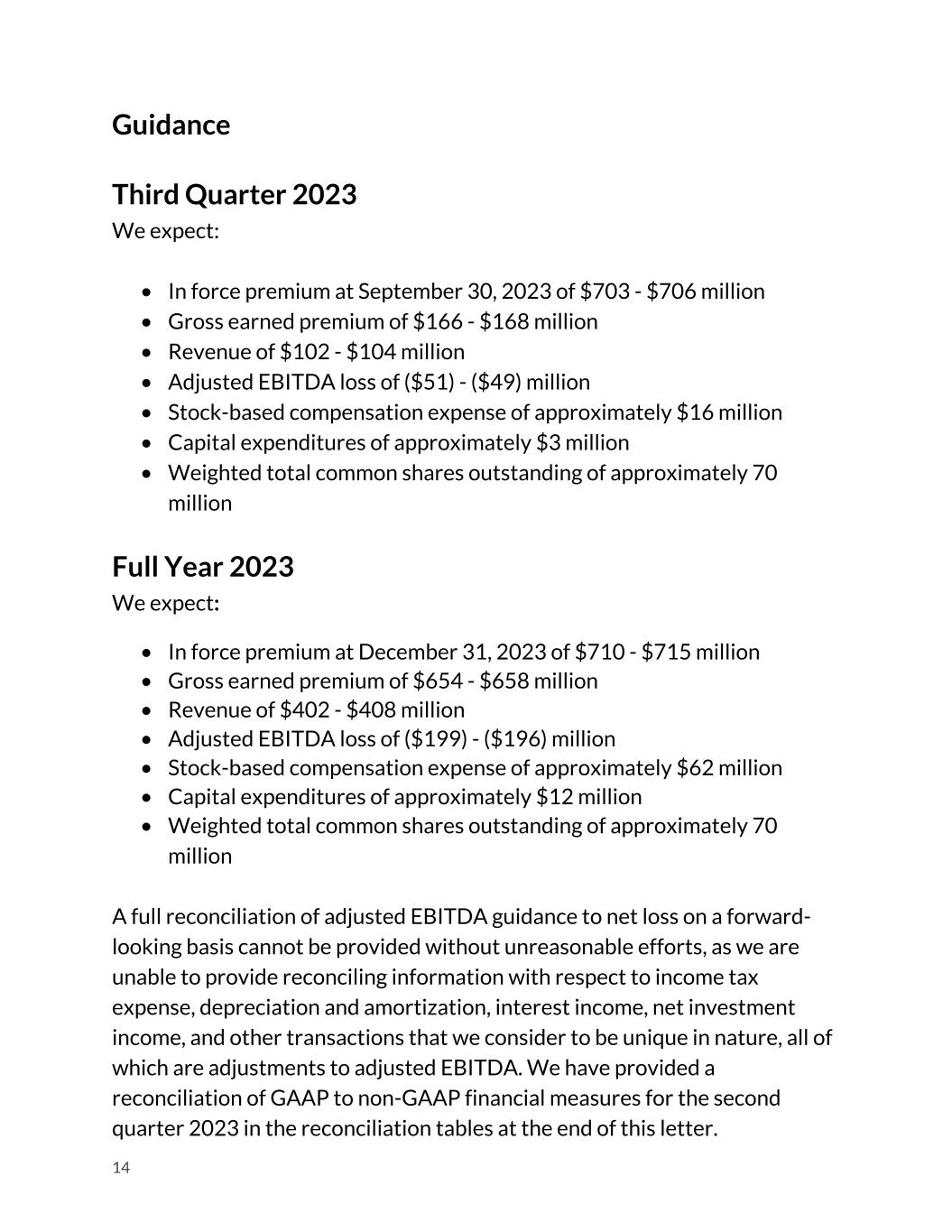
Guidance Third Quarter 2023 We expect: • In force premium at September 30, 2023 of $703 - $706 million • Gross earned premium of $166 - $168 million • Revenue of $102 - $104 million • Adjusted EBITDA loss of ($51) - ($49) million • Stock-based compensation expense of approximately $16 million • Capital expenditures of approximately $3 million • Weighted total common shares outstanding of approximately 70 million Full Year 2023 We expect: • In force premium at December 31, 2023 of $710 - $715 million • Gross earned premium of $654 - $658 million • Revenue of $402 - $408 million • Adjusted EBITDA loss of ($199) - ($196) million • Stock-based compensation expense of approximately $62 million • Capital expenditures of approximately $12 million • Weighted total common shares outstanding of approximately 70 million A full reconciliation of adjusted EBITDA guidance to net loss on a forward- looking basis cannot be provided without unreasonable efforts, as we are unable to provide reconciling information with respect to income tax expense, depreciation and amortization, interest income, net investment income, and other transactions that we consider to be unique in nature, all of which are adjustments to adjusted EBITDA. We have provided a reconciliation of GAAP to non-GAAP financial measures for the second quarter 2023 in the reconciliation tables at the end of this letter. 14
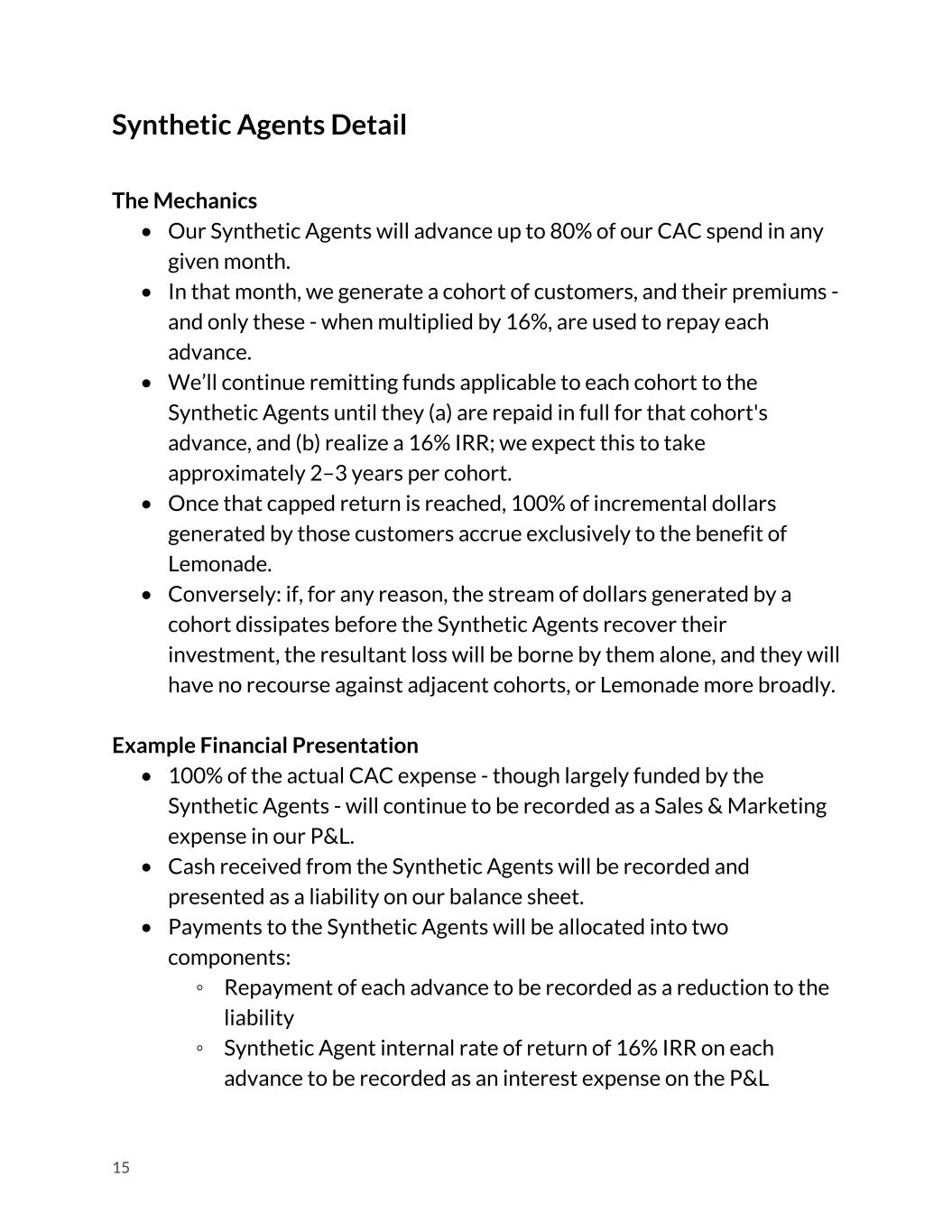
Synthetic Agents Detail The Mechanics • Our Synthetic Agents will advance up to 80% of our CAC spend in any given month. • In that month, we generate a cohort of customers, and their premiums - and only these - when multiplied by 16%, are used to repay each advance. • We’ll continue remitting funds applicable to each cohort to the Synthetic Agents until they (a) are repaid in full for that cohort's advance, and (b) realize a 16% IRR; we expect this to take approximately 2–3 years per cohort. • Once that capped return is reached, 100% of incremental dollars generated by those customers accrue exclusively to the benefit of Lemonade. • Conversely: if, for any reason, the stream of dollars generated by a cohort dissipates before the Synthetic Agents recover their investment, the resultant loss will be borne by them alone, and they will have no recourse against adjacent cohorts, or Lemonade more broadly. Example Financial Presentation • 100% of the actual CAC expense - though largely funded by the Synthetic Agents - will continue to be recorded as a Sales & Marketing expense in our P&L. • Cash received from the Synthetic Agents will be recorded and presented as a liability on our balance sheet. • Payments to the Synthetic Agents will be allocated into two components: ◦ Repayment of each advance to be recorded as a reduction to the liability ◦ Synthetic Agent internal rate of return of 16% IRR on each advance to be recorded as an interest expense on the P&L 15
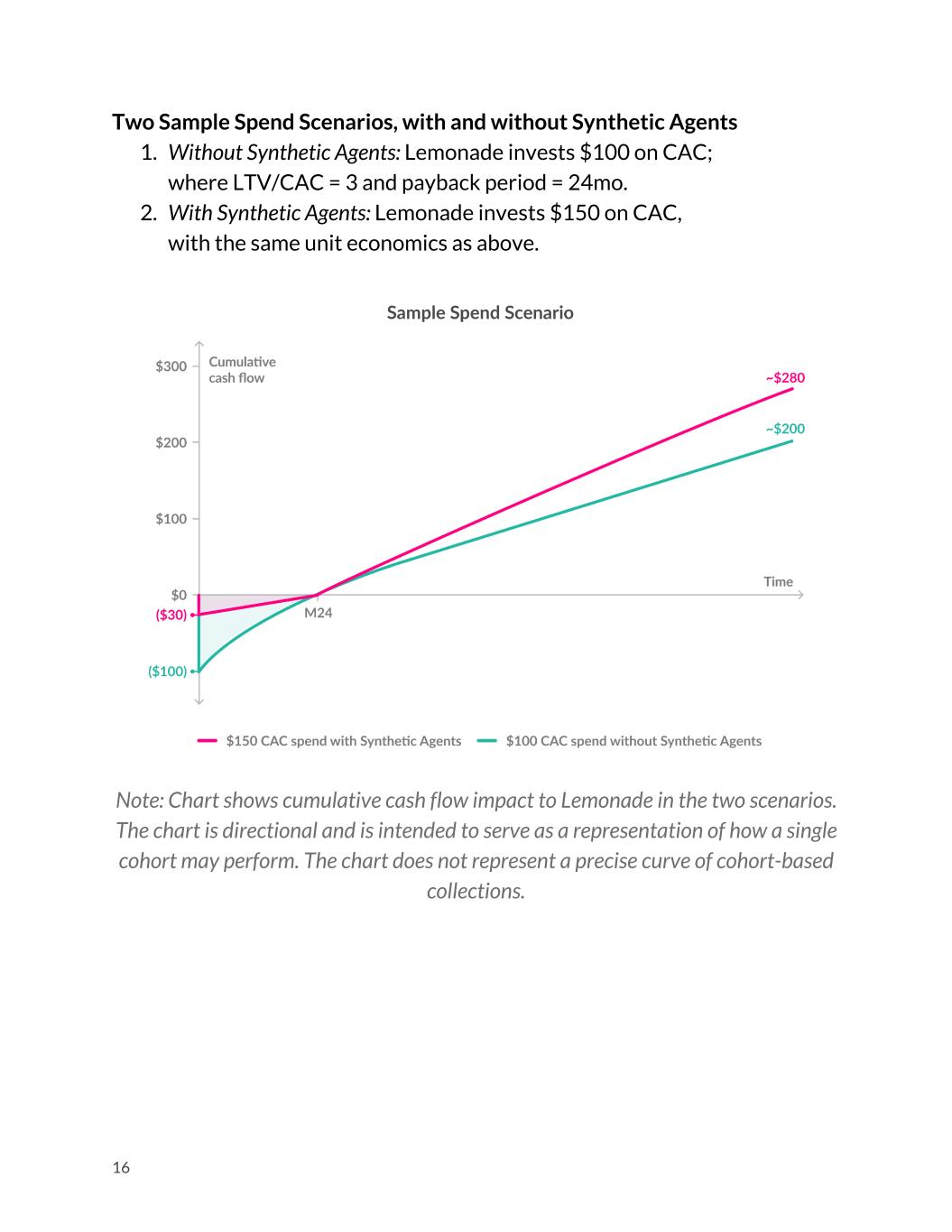
Two Sample Spend Scenarios, with and without Synthetic Agents 1. Without Synthetic Agents: Lemonade invests $100 on CAC; where LTV/CAC = 3 and payback period = 24mo. 2. With Synthetic Agents: Lemonade invests $150 on CAC, with the same unit economics as above. Note: Chart shows cumulative cash flow impact to Lemonade in the two scenarios. The chart is directional and is intended to serve as a representation of how a single cohort may perform. The chart does not represent a precise curve of cohort-based collections. 16
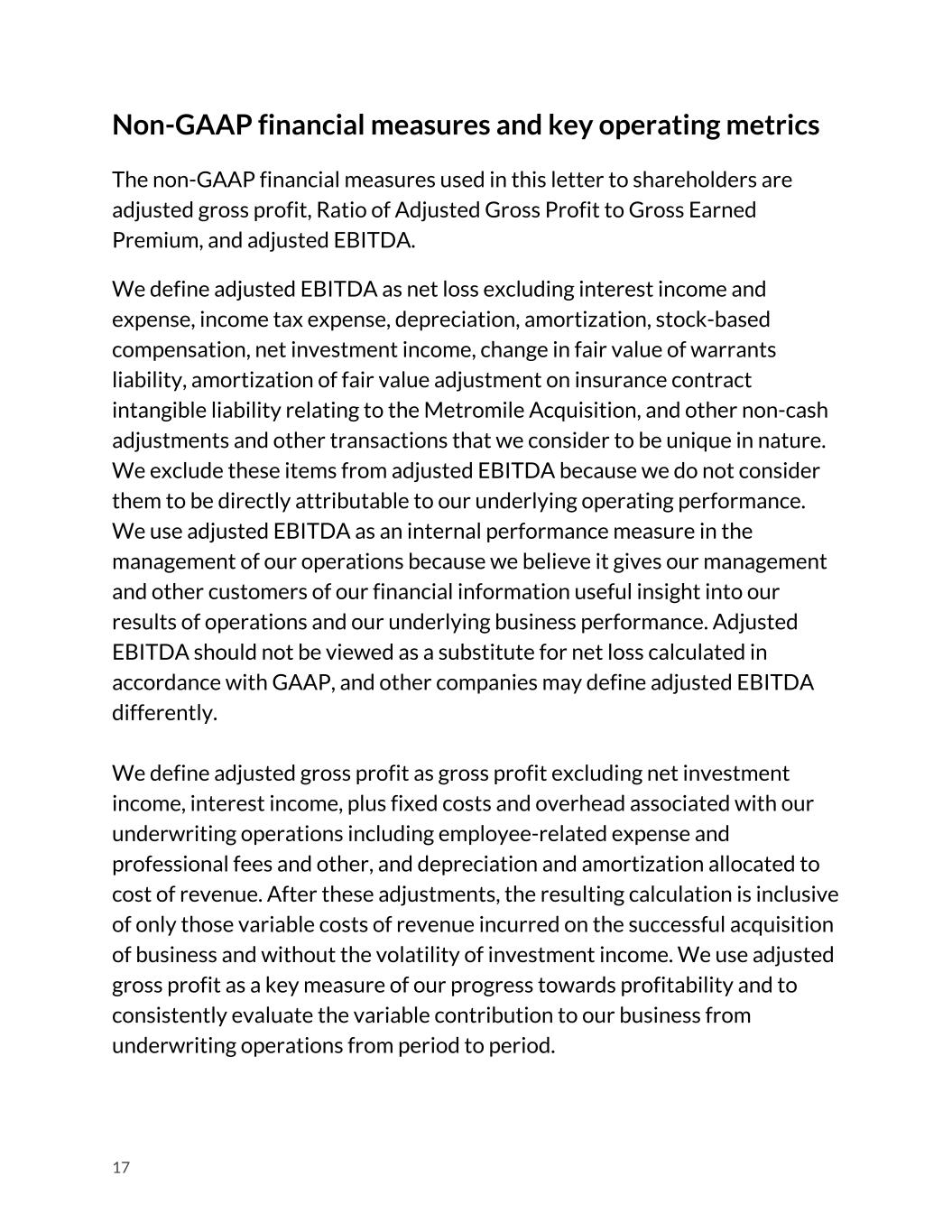
Non-GAAP financial measures and key operating metrics The non-GAAP financial measures used in this letter to shareholders are adjusted gross profit, Ratio of Adjusted Gross Profit to Gross Earned Premium, and adjusted EBITDA. We define adjusted EBITDA as net loss excluding interest income and expense, income tax expense, depreciation, amortization, stock-based compensation, net investment income, change in fair value of warrants liability, amortization of fair value adjustment on insurance contract intangible liability relating to the Metromile Acquisition, and other non-cash adjustments and other transactions that we consider to be unique in nature. We exclude these items from adjusted EBITDA because we do not consider them to be directly attributable to our underlying operating performance. We use adjusted EBITDA as an internal performance measure in the management of our operations because we believe it gives our management and other customers of our financial information useful insight into our results of operations and our underlying business performance. Adjusted EBITDA should not be viewed as a substitute for net loss calculated in accordance with GAAP, and other companies may define adjusted EBITDA differently. We define adjusted gross profit as gross profit excluding net investment income, interest income, plus fixed costs and overhead associated with our underwriting operations including employee-related expense and professional fees and other, and depreciation and amortization allocated to cost of revenue. After these adjustments, the resulting calculation is inclusive of only those variable costs of revenue incurred on the successful acquisition of business and without the volatility of investment income. We use adjusted gross profit as a key measure of our progress towards profitability and to consistently evaluate the variable contribution to our business from underwriting operations from period to period. 17
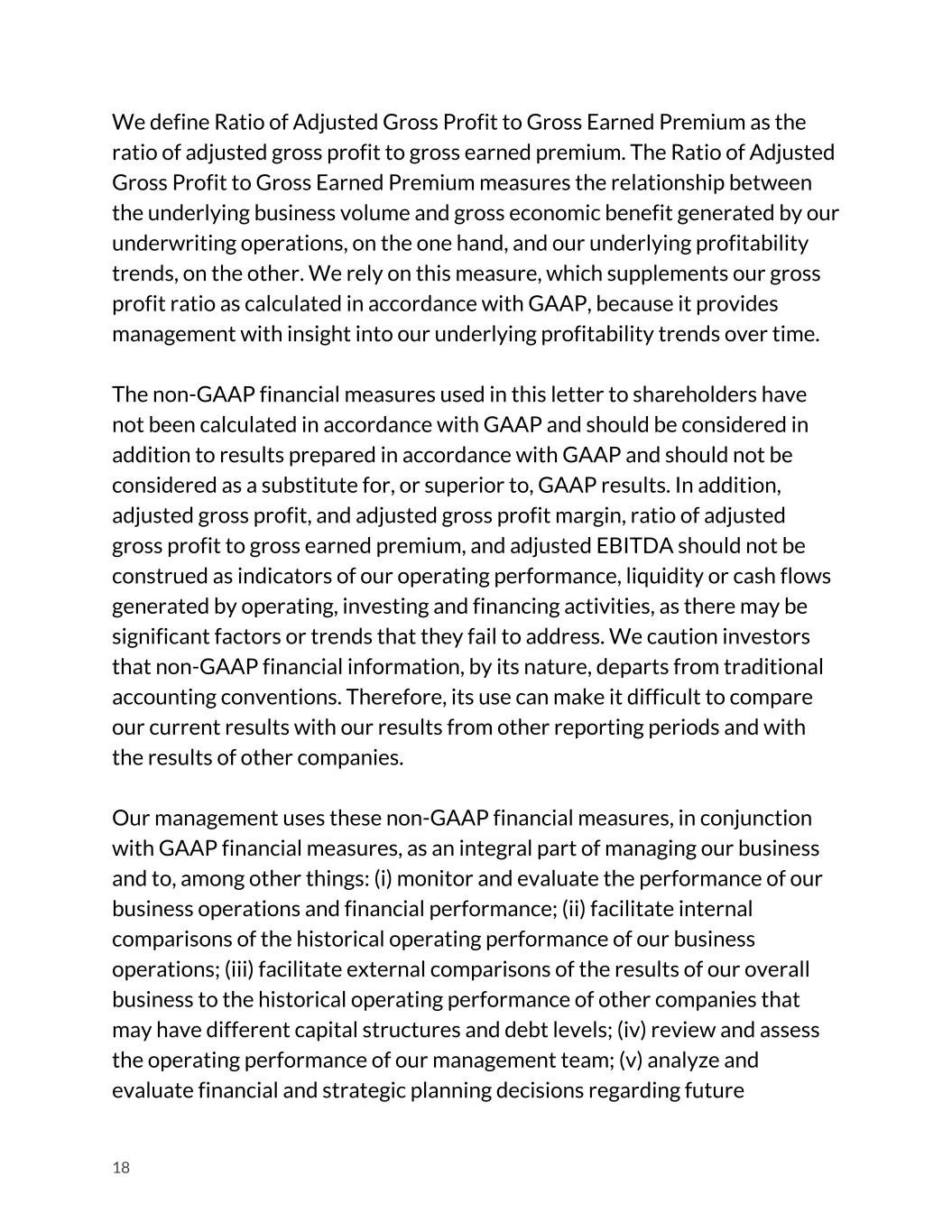
We define Ratio of Adjusted Gross Profit to Gross Earned Premium as the ratio of adjusted gross profit to gross earned premium. The Ratio of Adjusted Gross Profit to Gross Earned Premium measures the relationship between the underlying business volume and gross economic benefit generated by our underwriting operations, on the one hand, and our underlying profitability trends, on the other. We rely on this measure, which supplements our gross profit ratio as calculated in accordance with GAAP, because it provides management with insight into our underlying profitability trends over time. The non-GAAP financial measures used in this letter to shareholders have not been calculated in accordance with GAAP and should be considered in addition to results prepared in accordance with GAAP and should not be considered as a substitute for, or superior to, GAAP results. In addition, adjusted gross profit, and adjusted gross profit margin, ratio of adjusted gross profit to gross earned premium, and adjusted EBITDA should not be construed as indicators of our operating performance, liquidity or cash flows generated by operating, investing and financing activities, as there may be significant factors or trends that they fail to address. We caution investors that non-GAAP financial information, by its nature, departs from traditional accounting conventions. Therefore, its use can make it difficult to compare our current results with our results from other reporting periods and with the results of other companies. Our management uses these non-GAAP financial measures, in conjunction with GAAP financial measures, as an integral part of managing our business and to, among other things: (i) monitor and evaluate the performance of our business operations and financial performance; (ii) facilitate internal comparisons of the historical operating performance of our business operations; (iii) facilitate external comparisons of the results of our overall business to the historical operating performance of other companies that may have different capital structures and debt levels; (iv) review and assess the operating performance of our management team; (v) analyze and evaluate financial and strategic planning decisions regarding future 18
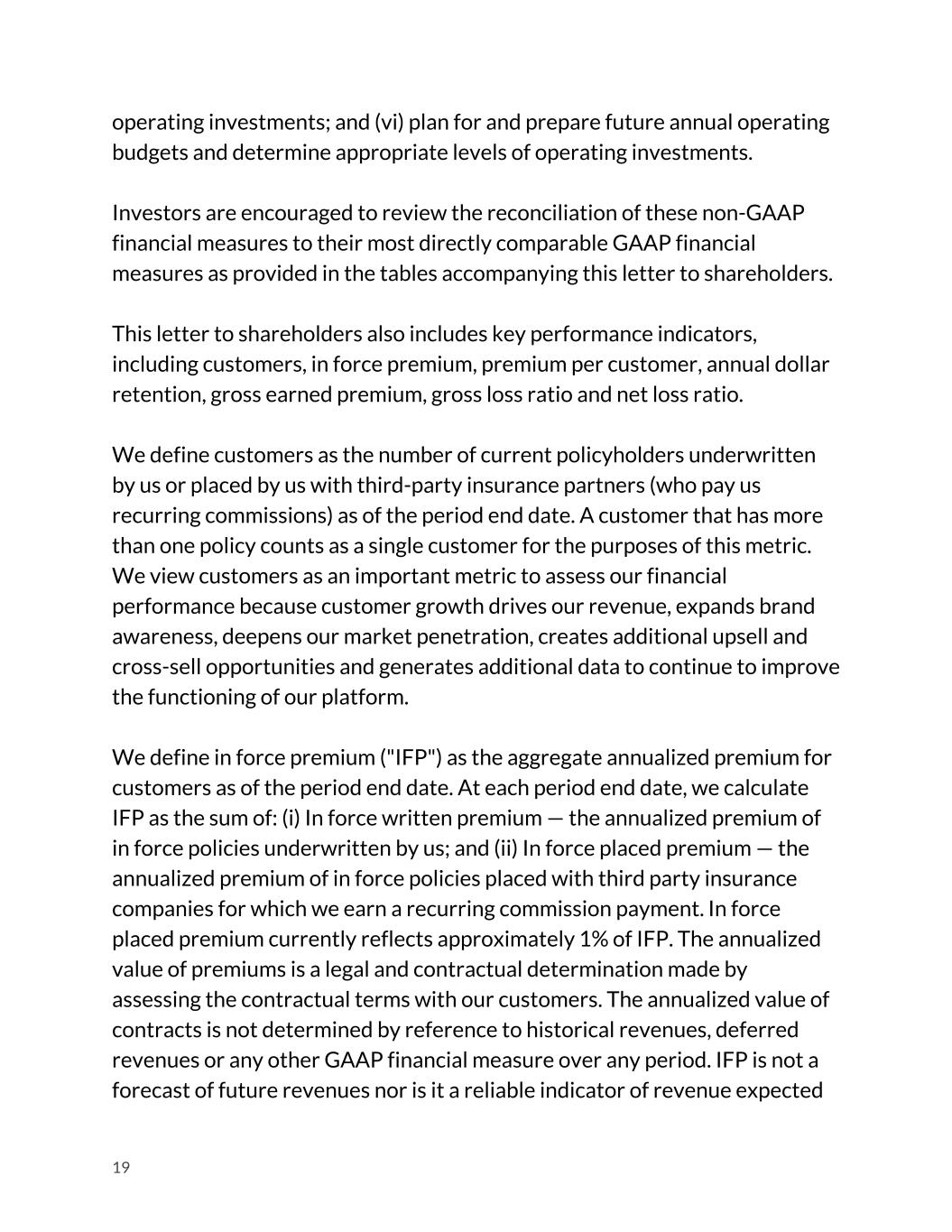
operating investments; and (vi) plan for and prepare future annual operating budgets and determine appropriate levels of operating investments. Investors are encouraged to review the reconciliation of these non-GAAP financial measures to their most directly comparable GAAP financial measures as provided in the tables accompanying this letter to shareholders. This letter to shareholders also includes key performance indicators, including customers, in force premium, premium per customer, annual dollar retention, gross earned premium, gross loss ratio and net loss ratio. We define customers as the number of current policyholders underwritten by us or placed by us with third-party insurance partners (who pay us recurring commissions) as of the period end date. A customer that has more than one policy counts as a single customer for the purposes of this metric. We view customers as an important metric to assess our financial performance because customer growth drives our revenue, expands brand awareness, deepens our market penetration, creates additional upsell and cross-sell opportunities and generates additional data to continue to improve the functioning of our platform. We define in force premium ("IFP") as the aggregate annualized premium for customers as of the period end date. At each period end date, we calculate IFP as the sum of: (i) In force written premium — the annualized premium of in force policies underwritten by us; and (ii) In force placed premium — the annualized premium of in force policies placed with third party insurance companies for which we earn a recurring commission payment. In force placed premium currently reflects approximately 1% of IFP. The annualized value of premiums is a legal and contractual determination made by assessing the contractual terms with our customers. The annualized value of contracts is not determined by reference to historical revenues, deferred revenues or any other GAAP financial measure over any period. IFP is not a forecast of future revenues nor is it a reliable indicator of revenue expected 19
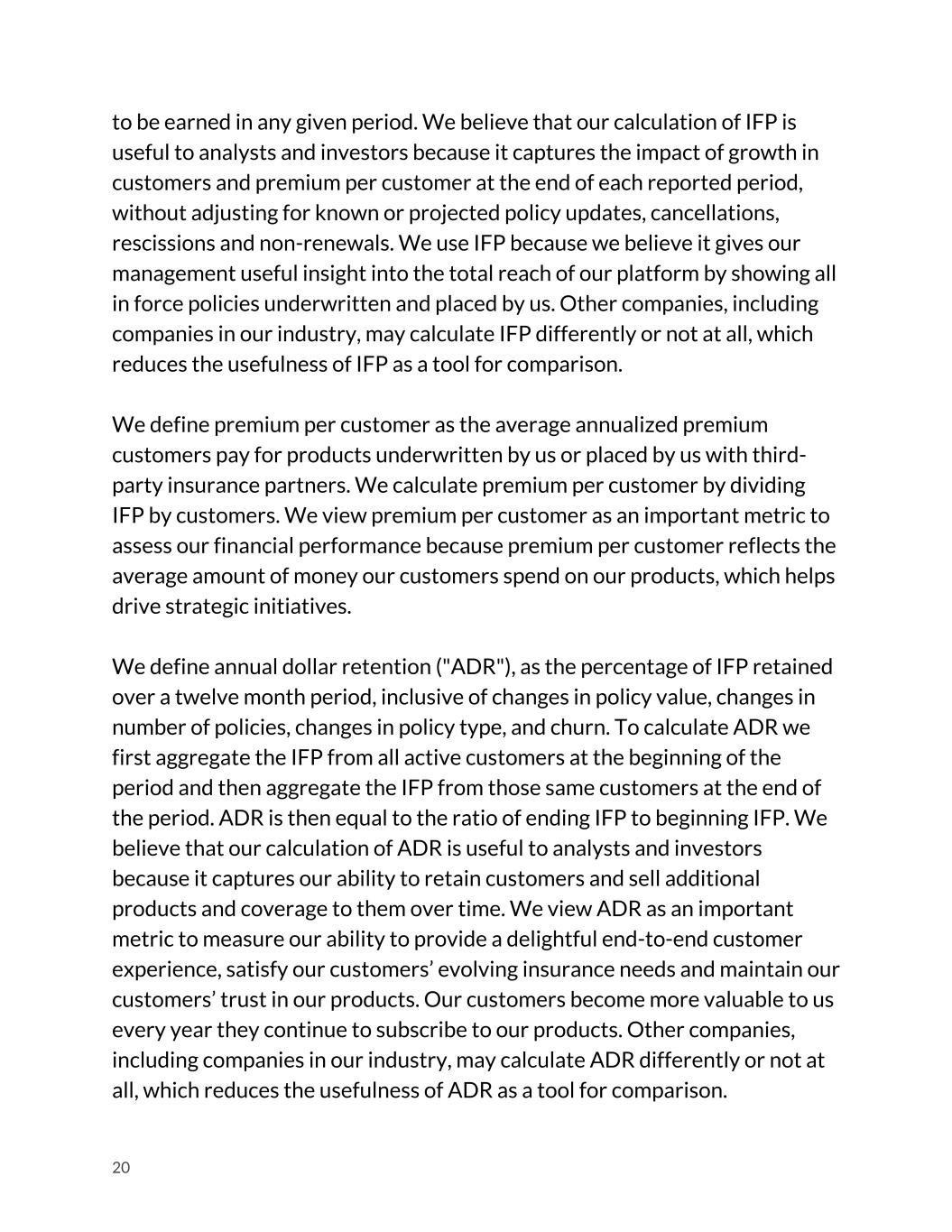
to be earned in any given period. We believe that our calculation of IFP is useful to analysts and investors because it captures the impact of growth in customers and premium per customer at the end of each reported period, without adjusting for known or projected policy updates, cancellations, rescissions and non-renewals. We use IFP because we believe it gives our management useful insight into the total reach of our platform by showing all in force policies underwritten and placed by us. Other companies, including companies in our industry, may calculate IFP differently or not at all, which reduces the usefulness of IFP as a tool for comparison. We define premium per customer as the average annualized premium customers pay for products underwritten by us or placed by us with third- party insurance partners. We calculate premium per customer by dividing IFP by customers. We view premium per customer as an important metric to assess our financial performance because premium per customer reflects the average amount of money our customers spend on our products, which helps drive strategic initiatives. We define annual dollar retention ("ADR"), as the percentage of IFP retained over a twelve month period, inclusive of changes in policy value, changes in number of policies, changes in policy type, and churn. To calculate ADR we first aggregate the IFP from all active customers at the beginning of the period and then aggregate the IFP from those same customers at the end of the period. ADR is then equal to the ratio of ending IFP to beginning IFP. We believe that our calculation of ADR is useful to analysts and investors because it captures our ability to retain customers and sell additional products and coverage to them over time. We view ADR as an important metric to measure our ability to provide a delightful end-to-end customer experience, satisfy our customers’ evolving insurance needs and maintain our customers’ trust in our products. Our customers become more valuable to us every year they continue to subscribe to our products. Other companies, including companies in our industry, may calculate ADR differently or not at all, which reduces the usefulness of ADR as a tool for comparison. 20
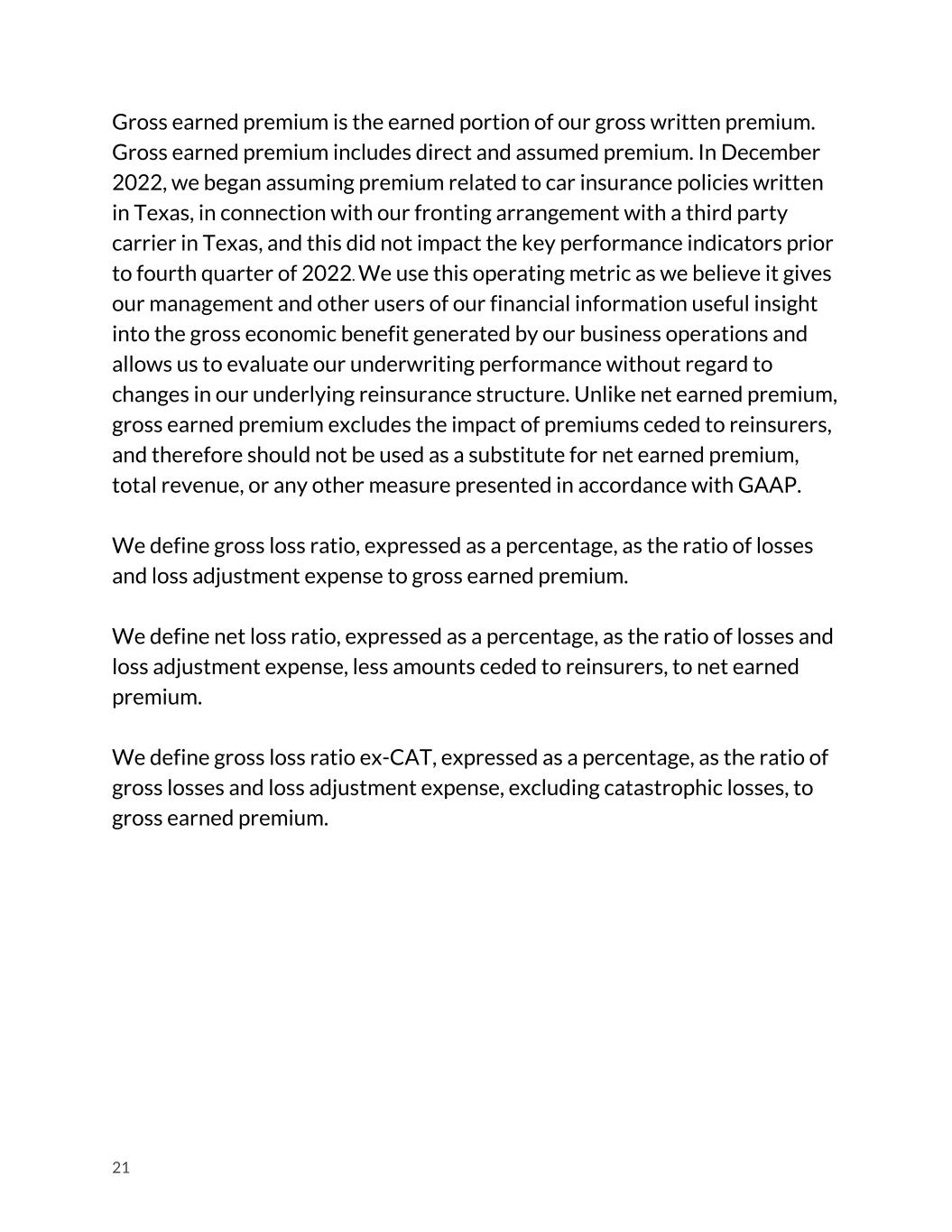
Gross earned premium is the earned portion of our gross written premium. Gross earned premium includes direct and assumed premium. In December 2022, we began assuming premium related to car insurance policies written in Texas, in connection with our fronting arrangement with a third party carrier in Texas, and this did not impact the key performance indicators prior to fourth quarter of 2022. We use this operating metric as we believe it gives our management and other users of our financial information useful insight into the gross economic benefit generated by our business operations and allows us to evaluate our underwriting performance without regard to changes in our underlying reinsurance structure. Unlike net earned premium, gross earned premium excludes the impact of premiums ceded to reinsurers, and therefore should not be used as a substitute for net earned premium, total revenue, or any other measure presented in accordance with GAAP. We define gross loss ratio, expressed as a percentage, as the ratio of losses and loss adjustment expense to gross earned premium. We define net loss ratio, expressed as a percentage, as the ratio of losses and loss adjustment expense, less amounts ceded to reinsurers, to net earned premium. We define gross loss ratio ex-CAT, expressed as a percentage, as the ratio of gross losses and loss adjustment expense, excluding catastrophic losses, to gross earned premium. 21
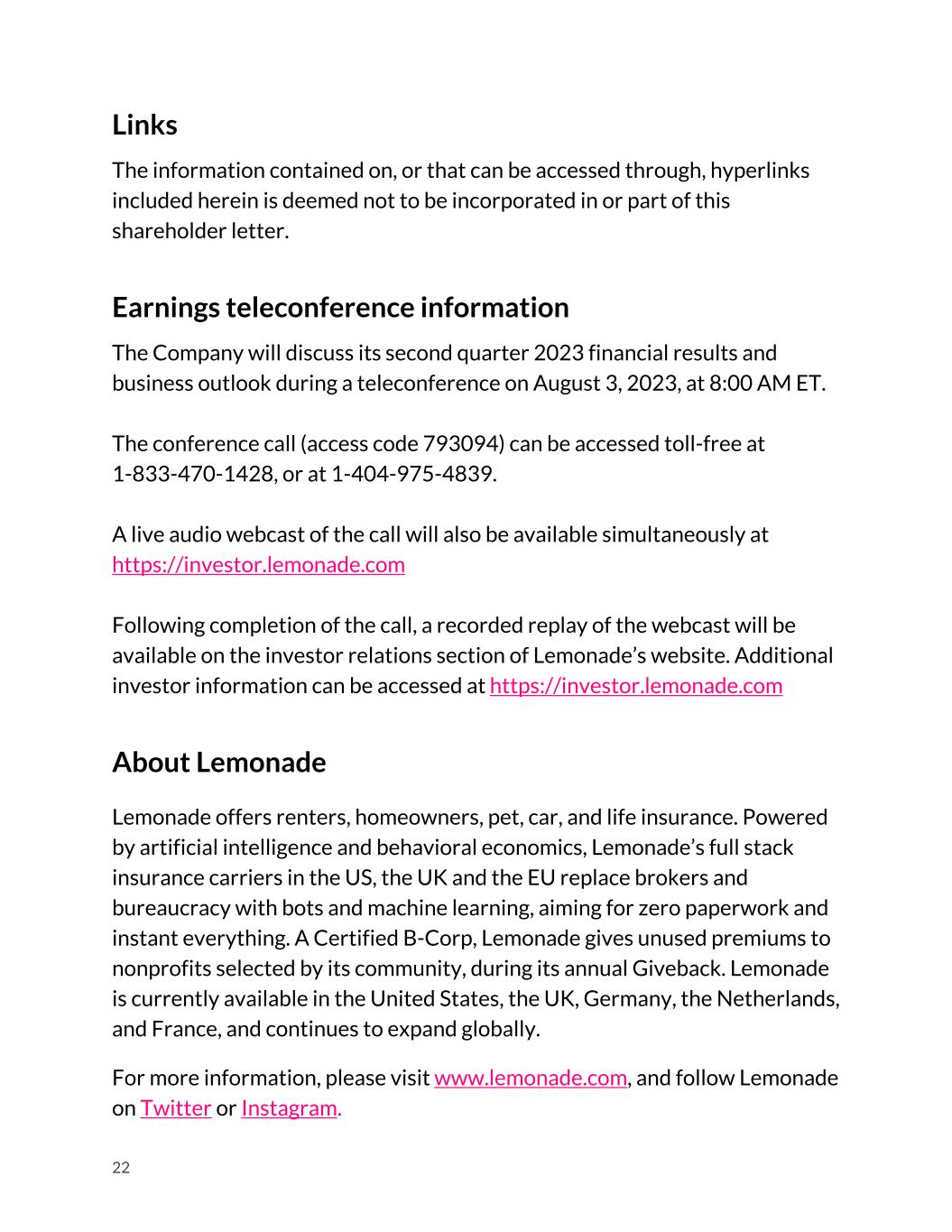
Links The information contained on, or that can be accessed through, hyperlinks included herein is deemed not to be incorporated in or part of this shareholder letter. Earnings teleconference information The Company will discuss its second quarter 2023 financial results and business outlook during a teleconference on August 3, 2023, at 8:00 AM ET. The conference call (access code 793094) can be accessed toll-free at 1-833-470-1428, or at 1-404-975-4839. A live audio webcast of the call will also be available simultaneously at https://investor.lemonade.com Following completion of the call, a recorded replay of the webcast will be available on the investor relations section of Lemonade’s website. Additional investor information can be accessed at https://investor.lemonade.com About Lemonade Lemonade offers renters, homeowners, pet, car, and life insurance. Powered by artificial intelligence and behavioral economics, Lemonade’s full stack insurance carriers in the US, the UK and the EU replace brokers and bureaucracy with bots and machine learning, aiming for zero paperwork and instant everything. A Certified B-Corp, Lemonade gives unused premiums to nonprofits selected by its community, during its annual Giveback. Lemonade is currently available in the United States, the UK, Germany, the Netherlands, and France, and continues to expand globally. For more information, please visit www.lemonade.com, and follow Lemonade on Twitter or Instagram. 22
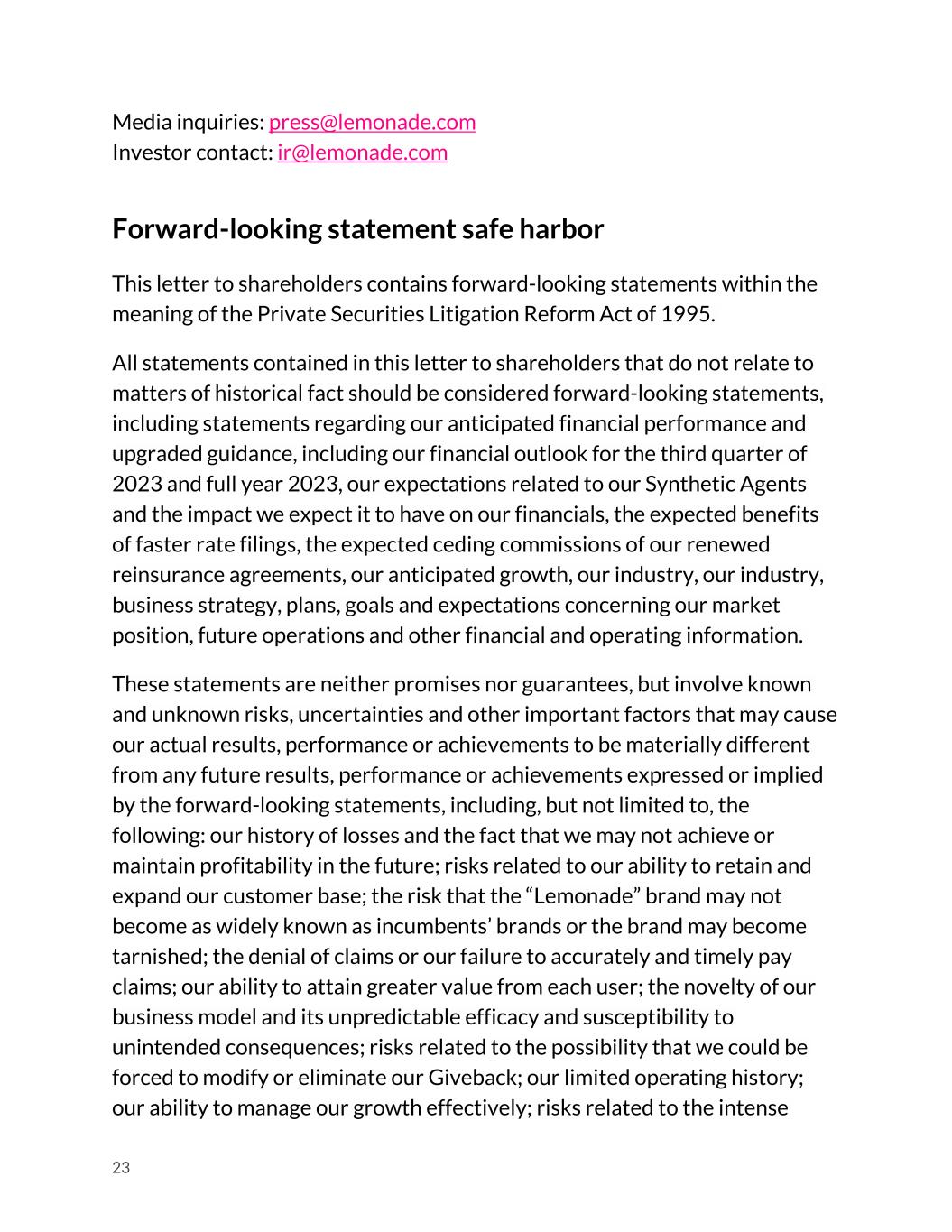
Media inquiries: press@lemonade.com Investor contact: ir@lemonade.com Forward-looking statement safe harbor This letter to shareholders contains forward-looking statements within the meaning of the Private Securities Litigation Reform Act of 1995. All statements contained in this letter to shareholders that do not relate to matters of historical fact should be considered forward-looking statements, including statements regarding our anticipated financial performance and upgraded guidance, including our financial outlook for the third quarter of 2023 and full year 2023, our expectations related to our Synthetic Agents and the impact we expect it to have on our financials, the expected benefits of faster rate filings, the expected ceding commissions of our renewed reinsurance agreements, our anticipated growth, our industry, our industry, business strategy, plans, goals and expectations concerning our market position, future operations and other financial and operating information. These statements are neither promises nor guarantees, but involve known and unknown risks, uncertainties and other important factors that may cause our actual results, performance or achievements to be materially different from any future results, performance or achievements expressed or implied by the forward-looking statements, including, but not limited to, the following: our history of losses and the fact that we may not achieve or maintain profitability in the future; risks related to our ability to retain and expand our customer base; the risk that the “Lemonade” brand may not become as widely known as incumbents’ brands or the brand may become tarnished; the denial of claims or our failure to accurately and timely pay claims; our ability to attain greater value from each user; the novelty of our business model and its unpredictable efficacy and susceptibility to unintended consequences; risks related to the possibility that we could be forced to modify or eliminate our Giveback; our limited operating history; our ability to manage our growth effectively; risks related to the intense 23

competition in the segments of the insurance industry in which we operate; risks related to the availability of reinsurance at current levels and prices; our exposure to counterparty risks; our ability to maintain our risk-based capital at the required levels; risks related to our ability to expand our product offerings; risks, including regulatory risks, related to the operation, development, and implementation of our proprietary artificial intelligence algorithms and telematics based pricing model; risks related to legislation or legal requirements that may affect how we communicate with customers; risks related to our reliance on artificial intelligence, telematics, mobile technology, and our digital platforms to collect data that we utilize in our business; risks related to our dependence on search engines, social media platforms, digital app stores, content-based online advertising and other online sources to attract consumers to our website and our online app; risks related to our ability to obtain additional capital to the extent required to grow our business, which may not be available on terms acceptable to us or at all; risks related to the loss of personal customer information as a result of security incidents or real or perceived errors, failures or bugs in our systems, website or app; risks related to periodic examinations by our primary state insurance regulators or by insurance regulators in other states in which we are licensed; risks related to our actual or perceived failure to protect customer information and other data, respect customers’ privacy, or comply with data privacy and security laws and regulations; risks related to underwriting risks accurately and charging competitive yet profitable rates to customers; risks related to potentially significant expenses incurred in connection with any new products before generating revenue from such products; risks associated with any costs incurred and other risks as we expand our business in the U.S. and internationally; risks related to our ability to successfully complete the combination of the businesses of Lemonade and Metromile and realize the anticipated benefits of the merger within the anticipated timeframes or cost expectations or at all; risks related to the cyclical nature of the insurance industry; risks related to our ability to comply with extensive insurance industry regulations and additional regulatory requirements specific to other vertical markets that we enter or have entered; risks related to our ability to predict the impacts of severe weather 24
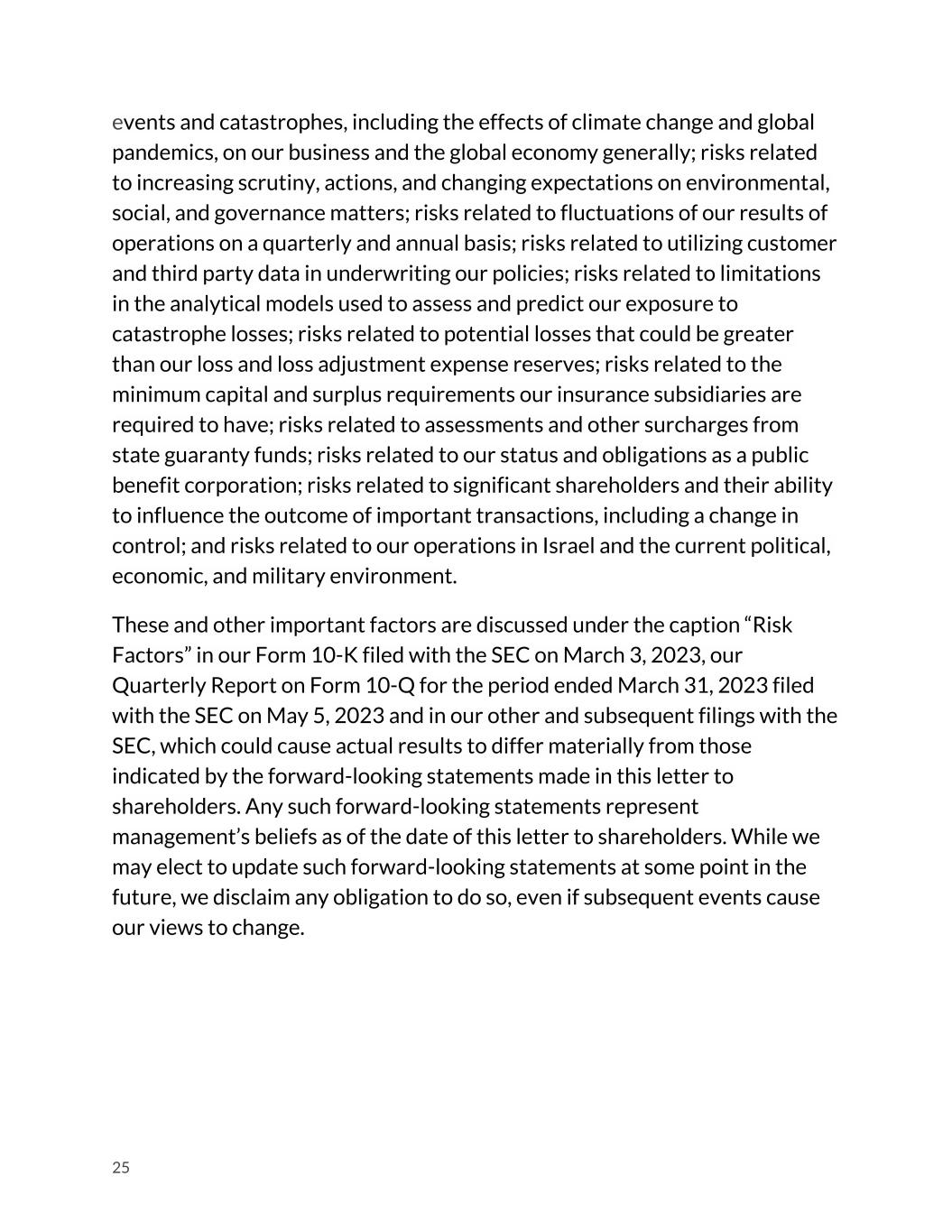
events and catastrophes, including the effects of climate change and global pandemics, on our business and the global economy generally; risks related to increasing scrutiny, actions, and changing expectations on environmental, social, and governance matters; risks related to fluctuations of our results of operations on a quarterly and annual basis; risks related to utilizing customer and third party data in underwriting our policies; risks related to limitations in the analytical models used to assess and predict our exposure to catastrophe losses; risks related to potential losses that could be greater than our loss and loss adjustment expense reserves; risks related to the minimum capital and surplus requirements our insurance subsidiaries are required to have; risks related to assessments and other surcharges from state guaranty funds; risks related to our status and obligations as a public benefit corporation; risks related to significant shareholders and their ability to influence the outcome of important transactions, including a change in control; and risks related to our operations in Israel and the current political, economic, and military environment. These and other important factors are discussed under the caption “Risk Factors” in our Form 10-K filed with the SEC on March 3, 2023, our Quarterly Report on Form 10-Q for the period ended March 31, 2023 filed with the SEC on May 5, 2023 and in our other and subsequent filings with the SEC, which could cause actual results to differ materially from those indicated by the forward-looking statements made in this letter to shareholders. Any such forward-looking statements represent management’s beliefs as of the date of this letter to shareholders. While we may elect to update such forward-looking statements at some point in the future, we disclaim any obligation to do so, even if subsequent events cause our views to change. 25
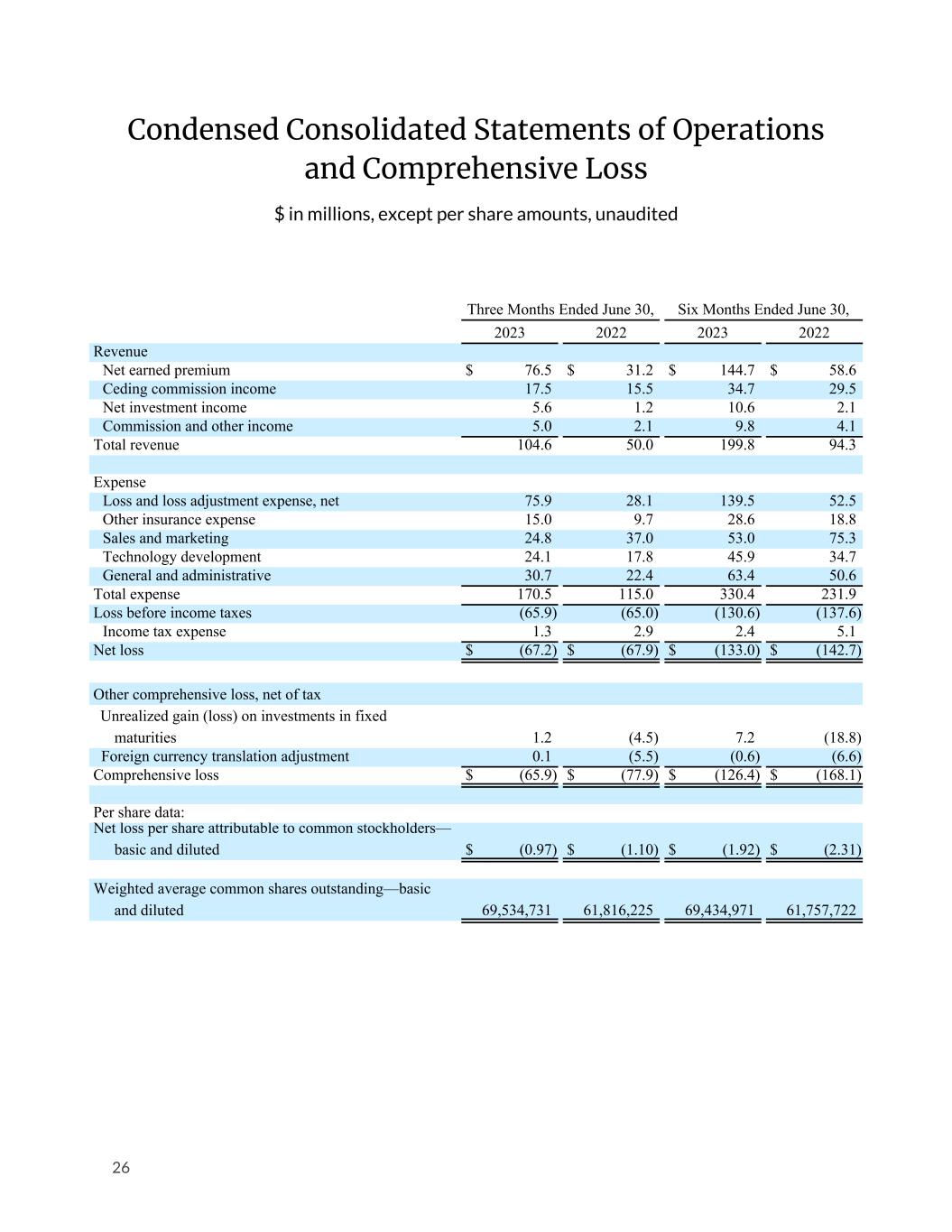
Condensed Consolidated Statements of Operations and Comprehensive Loss $ in millions, except per share amounts, unaudited Three Months Ended June 30, Six Months Ended June 30, 2023 2022 2023 2022 Revenue Net earned premium $ 76.5 $ 31.2 $ 144.7 $ 58.6 Ceding commission income 17.5 15.5 34.7 29.5 Net investment income 5.6 1.2 10.6 2.1 Commission and other income 5.0 2.1 9.8 4.1 Total revenue 104.6 50.0 199.8 94.3 Expense Loss and loss adjustment expense, net 75.9 28.1 139.5 52.5 Other insurance expense 15.0 9.7 28.6 18.8 Sales and marketing 24.8 37.0 53.0 75.3 Technology development 24.1 17.8 45.9 34.7 General and administrative 30.7 22.4 63.4 50.6 Total expense 170.5 115.0 330.4 231.9 Loss before income taxes (65.9) (65.0) (130.6) (137.6) Income tax expense 1.3 2.9 2.4 5.1 Net loss $ (67.2) $ (67.9) $ (133.0) $ (142.7) Other comprehensive loss, net of tax Unrealized gain (loss) on investments in fixed maturities 1.2 (4.5) 7.2 (18.8) Foreign currency translation adjustment 0.1 (5.5) (0.6) (6.6) Comprehensive loss $ (65.9) $ (77.9) $ (126.4) $ (168.1) Per share data: Net loss per share attributable to common stockholders— basic and diluted $ (0.97) $ (1.10) $ (1.92) $ (2.31) Weighted average common shares outstanding—basic and diluted 69,534,731 61,816,225 69,434,971 61,757,722 26
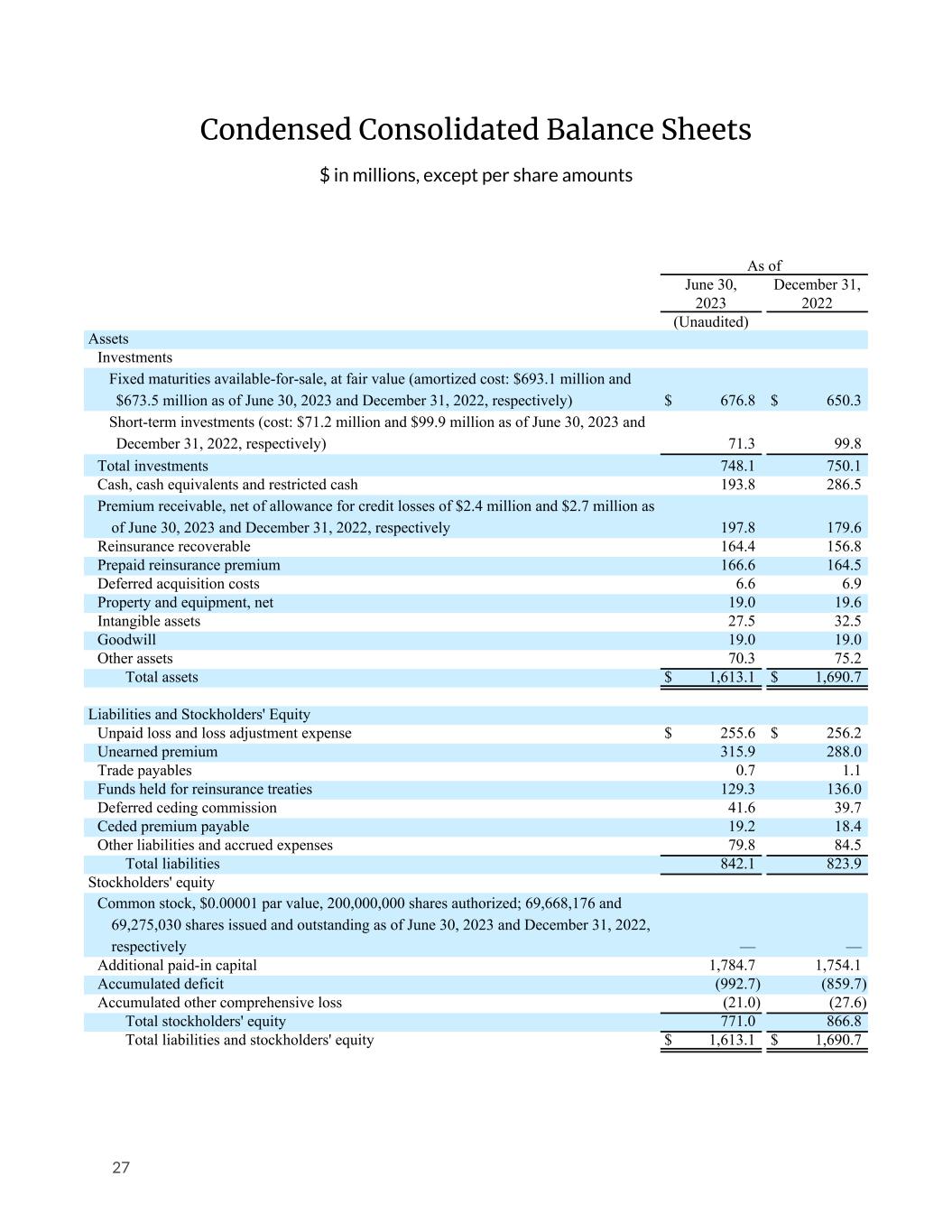
Condensed Consolidated Balance Sheets $ in millions, except per share amounts As of June 30, December 31, 2023 2022 (Unaudited) Assets Investments Fixed maturities available-for-sale, at fair value (amortized cost: $693.1 million and $673.5 million as of June 30, 2023 and December 31, 2022, respectively) $ 676.8 $ 650.3 Short-term investments (cost: $71.2 million and $99.9 million as of June 30, 2023 and December 31, 2022, respectively) 71.3 99.8 Total investments 748.1 750.1 Cash, cash equivalents and restricted cash 193.8 286.5 Premium receivable, net of allowance for credit losses of $2.4 million and $2.7 million as of June 30, 2023 and December 31, 2022, respectively 197.8 179.6 Reinsurance recoverable 164.4 156.8 Prepaid reinsurance premium 166.6 164.5 Deferred acquisition costs 6.6 6.9 Property and equipment, net 19.0 19.6 Intangible assets 27.5 32.5 Goodwill 19.0 19.0 Other assets 70.3 75.2 Total assets $ 1,613.1 $ 1,690.7 Liabilities and Stockholders' Equity Unpaid loss and loss adjustment expense $ 255.6 $ 256.2 Unearned premium 315.9 288.0 Trade payables 0.7 1.1 Funds held for reinsurance treaties 129.3 136.0 Deferred ceding commission 41.6 39.7 Ceded premium payable 19.2 18.4 Other liabilities and accrued expenses 79.8 84.5 Total liabilities 842.1 823.9 Stockholders' equity Common stock, $0.00001 par value, 200,000,000 shares authorized; 69,668,176 and 69,275,030 shares issued and outstanding as of June 30, 2023 and December 31, 2022, respectively — — Additional paid-in capital 1,784.7 1,754.1 Accumulated deficit (992.7) (859.7) Accumulated other comprehensive loss (21.0) (27.6) Total stockholders' equity 771.0 866.8 Total liabilities and stockholders' equity $ 1,613.1 $ 1,690.7 27

Condensed Consolidated Statements of Cash Flows $ in millions, unaudited Six Months Ended June 30, 2023 2022 Cash flows from operating activities: Net loss $ (133.0) $ (142.7) Adjustments to reconcile net loss to net cash used in operating activities: Depreciation and amortization 10.2 3.1 Stock-based compensation 30.2 28.0 Amortization of discount on bonds — 4.6 Provision for bad debt 3.9 3.6 Changes in operating assets and liabilities: Premium receivable (22.1) (24.2) Reinsurance recoverable (7.6) (20.6) Prepaid reinsurance premium (2.1) (19.3) Deferred acquisition costs 0.3 (1.2) Other assets 5.2 (0.3) Unpaid loss and loss adjustment expense (0.6) 25.0 Unearned premium 27.9 33.9 Trade payables (0.4) 0.3 Funds held for reinsurance treaties (6.7) 16.1 Deferred ceding commissions 1.9 5.6 Ceded premium payable 0.8 2.3 Other liabilities and accrued expenses (4.6) 6.1 Net cash used in operating activities (96.7) (79.7) Cash flows from investing activities: Proceeds from short-term investments sold or matured 63.2 81.5 Proceeds from bonds sold or matured 216.0 53.7 Cost of short-term investments acquired (52.2) (57.3) Cost of bonds acquired (218.0) (60.3) Purchases of property and equipment (4.6) (4.6) Net cash provided by investing activities 4.4 13.0 Cash flows from financing activities: Proceeds from stock exercises 0.3 1.0 Net cash provided by financing activities 0.3 1.0 Effect of exchange rate changes on cash, cash equivalents and restricted cash (0.7) (5.3) Net decrease in cash, cash equivalents and restricted cash (92.7) (71.0) Cash, cash equivalents and restricted cash at beginning of period 286.5 270.6 Cash, cash equivalents and restricted cash at end of period $ 193.8 $ 199.6 Supplemental disclosure of cash flow information: Cash paid for income taxes $ 0.3 $ 2.7 28
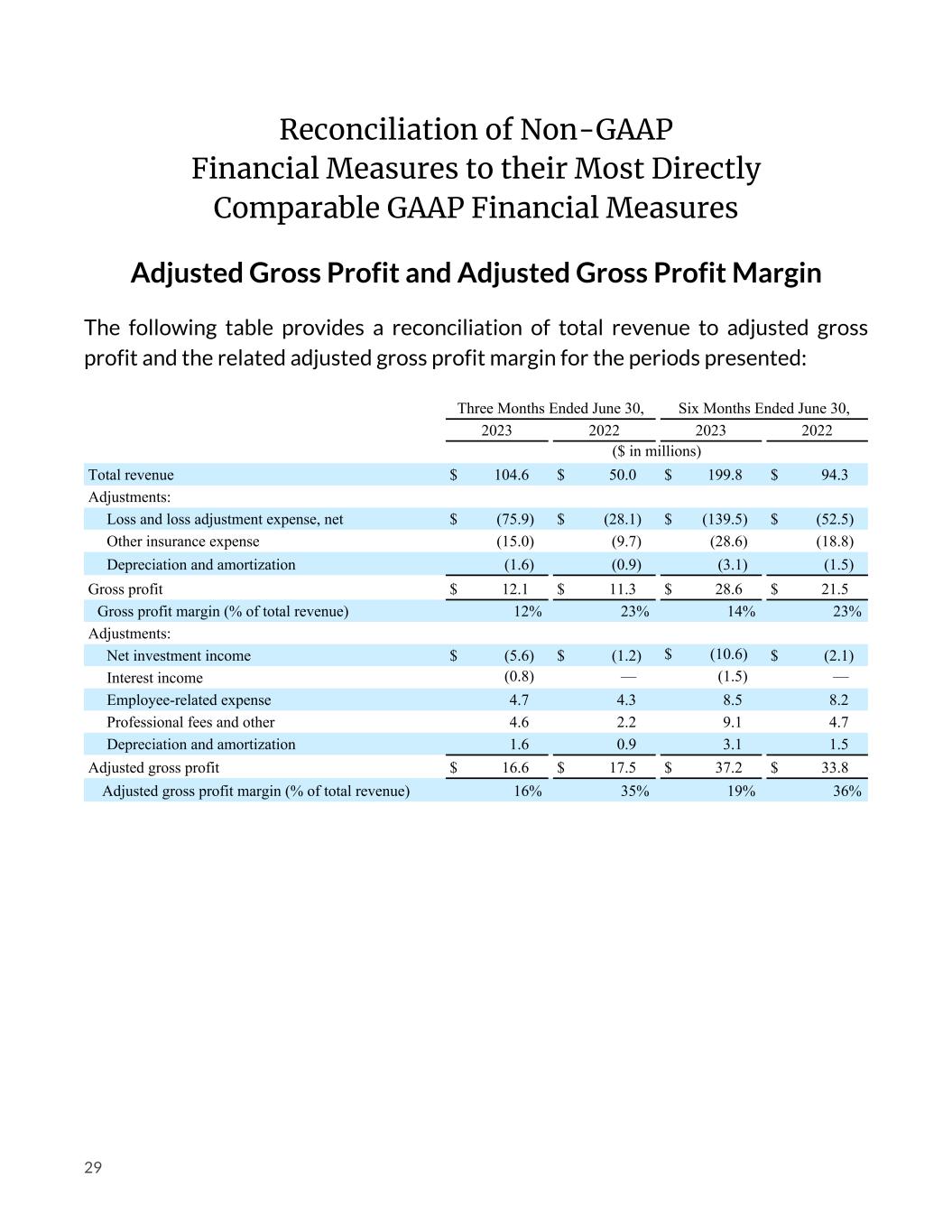
Reconciliation of Non-GAAP Financial Measures to their Most Directly Comparable GAAP Financial Measures Adjusted Gross Profit and Adjusted Gross Profit Margin The following table provides a reconciliation of total revenue to adjusted gross profit and the related adjusted gross profit margin for the periods presented: Three Months Ended June 30, Six Months Ended June 30, 2023 2022 2023 2022 ($ in millions) Total revenue $ 104.6 $ 50.0 $ 199.8 $ 94.3 Adjustments: Loss and loss adjustment expense, net $ (75.9) $ (28.1) $ (139.5) $ (52.5) Other insurance expense (15.0) (9.7) (28.6) (18.8) Depreciation and amortization (1.6) (0.9) (3.1) (1.5) Gross profit $ 12.1 $ 11.3 $ 28.6 $ 21.5 Gross profit margin (% of total revenue) 12% 23% 14% 23% Adjustments: Net investment income $ (5.6) $ (1.2) $ (10.6) $ (2.1) Interest income (0.8) — (1.5) — Employee-related expense 4.7 4.3 8.5 8.2 Professional fees and other 4.6 2.2 9.1 4.7 Depreciation and amortization 1.6 0.9 3.1 1.5 Adjusted gross profit $ 16.6 $ 17.5 $ 37.2 $ 33.8 Adjusted gross profit margin (% of total revenue) 16% 35% 19% 36% 29
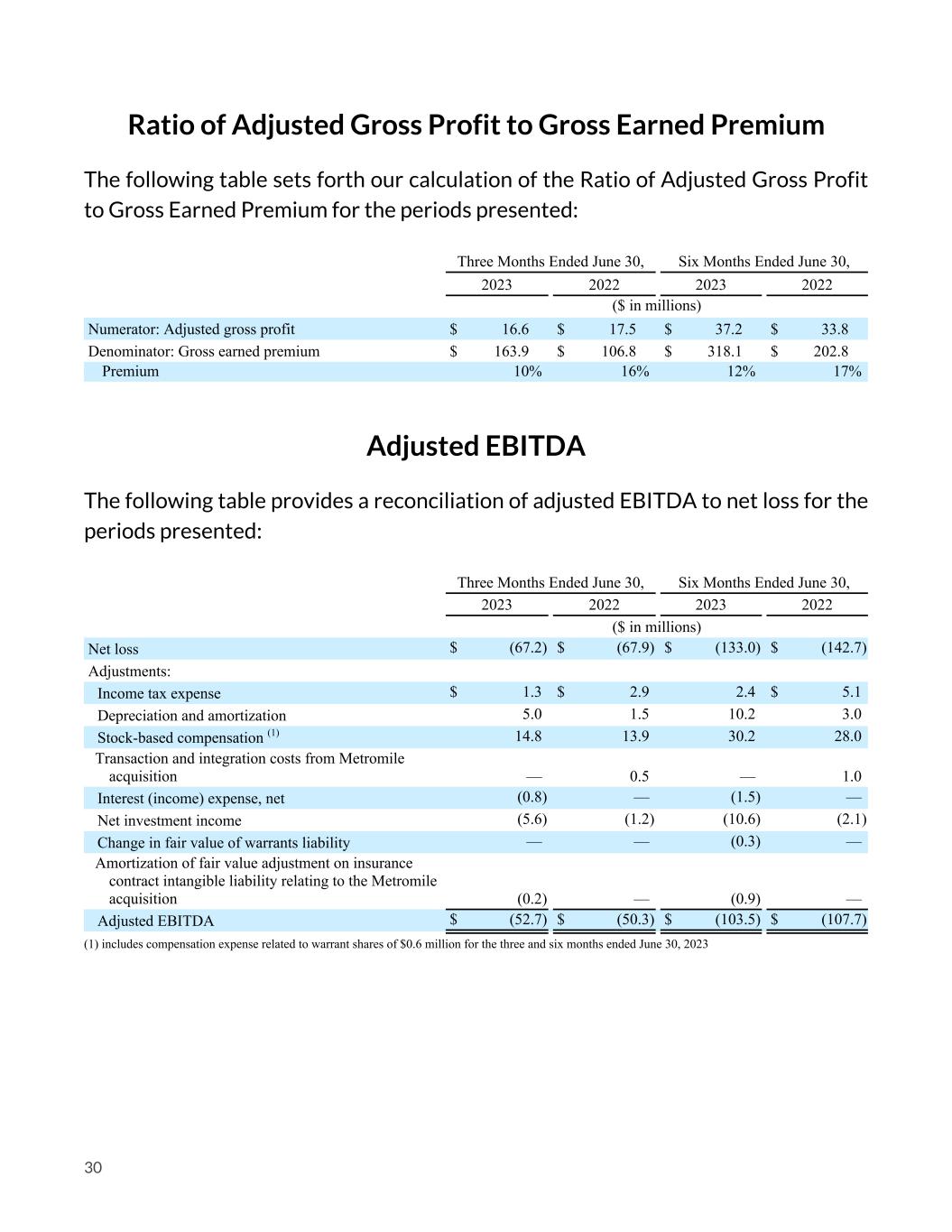
Ratio of Adjusted Gross Profit to Gross Earned Premium The following table sets forth our calculation of the Ratio of Adjusted Gross Profit to Gross Earned Premium for the periods presented: Three Months Ended June 30, Six Months Ended June 30, 2023 2022 2023 2022 ($ in millions) Numerator: Adjusted gross profit $ 16.6 $ 17.5 $ 37.2 $ 33.8 Denominator: Gross earned premium $ 163.9 $ 106.8 $ 318.1 $ 202.8 Premium 10% 16% 12% 17% Adjusted EBITDA The following table provides a reconciliation of adjusted EBITDA to net loss for the periods presented: Three Months Ended June 30, Six Months Ended June 30, 2023 2022 2023 2022 ($ in millions) Net loss $ (67.2) $ (67.9) $ (133.0) $ (142.7) Adjustments: Income tax expense $ 1.3 $ 2.9 2.4 $ 5.1 Depreciation and amortization 5.0 1.5 10.2 3.0 Stock-based compensation (1) 14.8 13.9 30.2 28.0 Transaction and integration costs from Metromile acquisition — 0.5 — 1.0 Interest (income) expense, net (0.8) — (1.5) — Net investment income (5.6) (1.2) (10.6) (2.1) Change in fair value of warrants liability — — (0.3) — Amortization of fair value adjustment on insurance contract intangible liability relating to the Metromile acquisition (0.2) — (0.9) — Adjusted EBITDA $ (52.7) $ (50.3) $ (103.5) $ (107.7) (1) includes compensation expense related to warrant shares of $0.6 million for the three and six months ended June 30, 2023 30
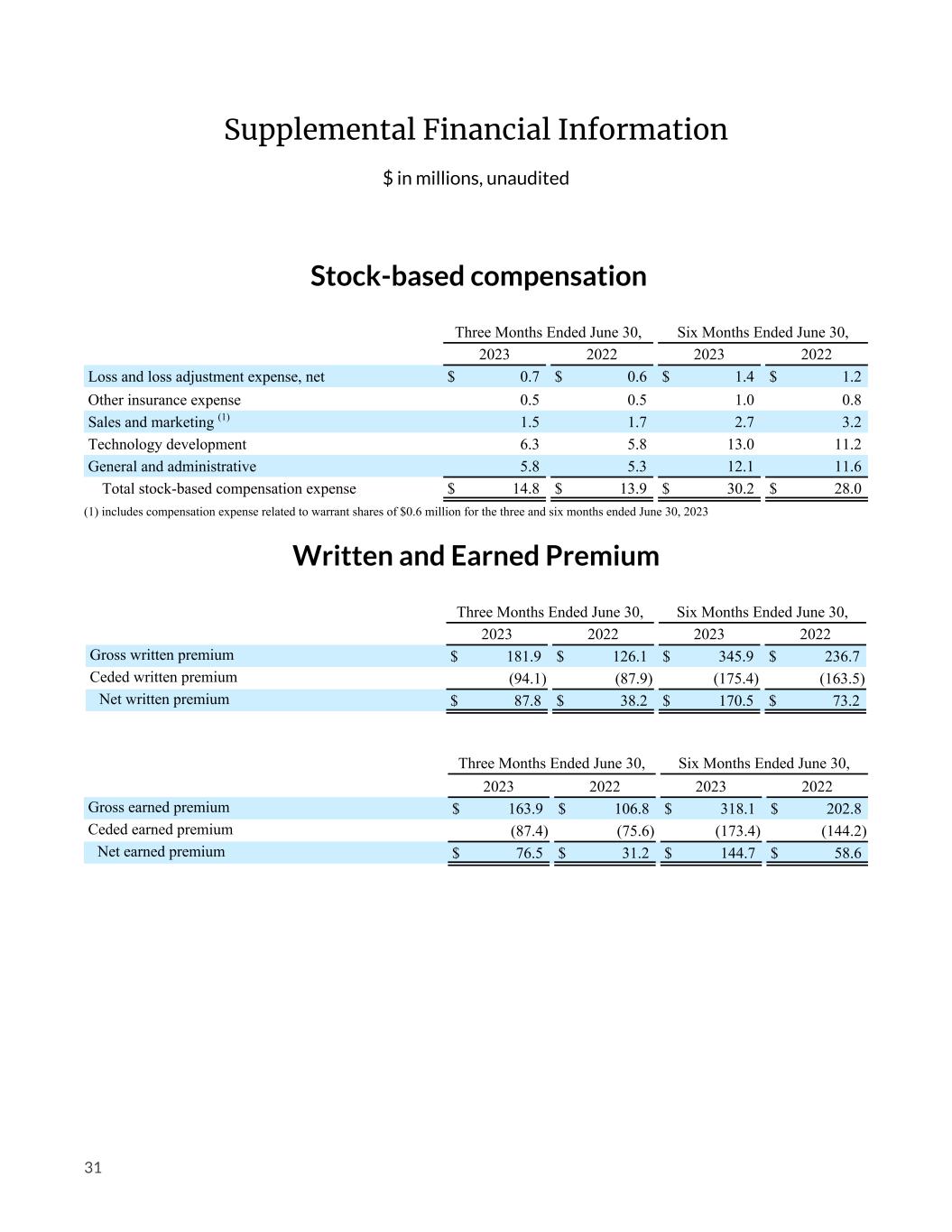
Supplemental Financial Information $ in millions, unaudited Stock-based compensation Three Months Ended June 30, Six Months Ended June 30, 2023 2022 2023 2022 Loss and loss adjustment expense, net $ 0.7 $ 0.6 $ 1.4 $ 1.2 Other insurance expense 0.5 0.5 1.0 0.8 Sales and marketing (1) 1.5 1.7 2.7 3.2 Technology development 6.3 5.8 13.0 11.2 General and administrative 5.8 5.3 12.1 11.6 Total stock-based compensation expense $ 14.8 $ 13.9 $ 30.2 $ 28.0 (1) includes compensation expense related to warrant shares of $0.6 million for the three and six months ended June 30, 2023 Written and Earned Premium Three Months Ended June 30, Six Months Ended June 30, 2023 2022 2023 2022 Gross written premium $ 181.9 $ 126.1 $ 345.9 $ 236.7 Ceded written premium (94.1) (87.9) (175.4) (163.5) Net written premium $ 87.8 $ 38.2 $ 170.5 $ 73.2 Three Months Ended June 30, Six Months Ended June 30, 2023 2022 2023 2022 Gross earned premium $ 163.9 $ 106.8 $ 318.1 $ 202.8 Ceded earned premium (87.4) (75.6) (173.4) (144.2) Net earned premium $ 76.5 $ 31.2 $ 144.7 $ 58.6 31
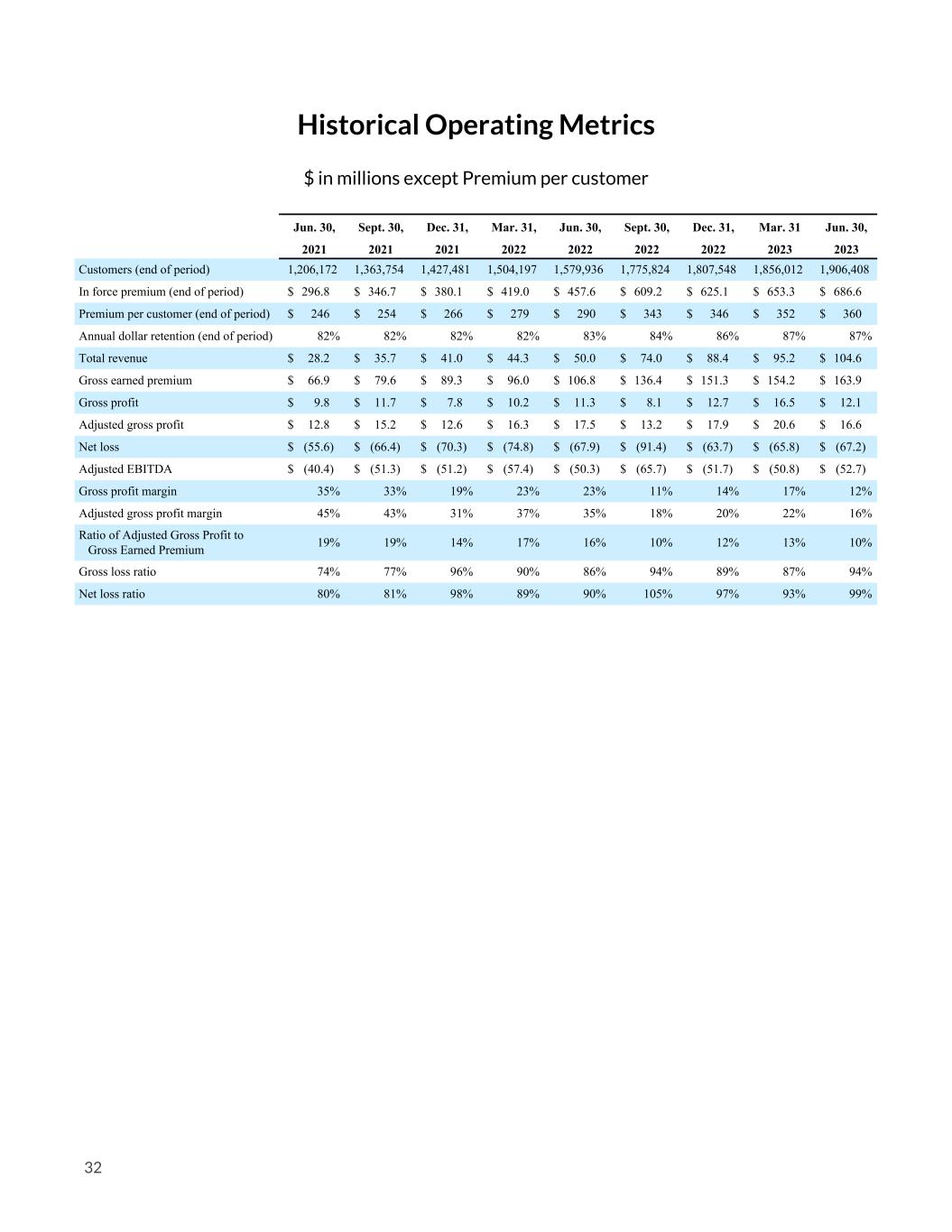
Historical Operating Metrics $ in millions except Premium per customer Jun. 30, Sept. 30, Dec. 31, Mar. 31, Jun. 30, Sept. 30, Dec. 31, Mar. 31 Jun. 30, 2021 2021 2021 2022 2022 2022 2022 2023 2023 Customers (end of period) 1,206,172 1,206,172 1,363,754 1,427,481 1,504,197 1,579,936 1,775,824 1,807,548 1,856,012 1,906,408 In force premium (end of period) $ 296.8 $ 346.7 $ 380.1 $ 419.0 $ 457.6 $ 609.2 $ 625.1 $ 653.3 $ 686.6 Premium per customer (end of period) $ 246 $ 254 $ 266 $ 279 $ 290 $ 343 $ 346 $ 352 $ 360 Annual dollar retention (end of period) 82% 82% 82% 82% 83% 84% 86% 87% 87% Total revenue $ 28.2 $ 35.7 $ 41.0 $ 44.3 $ 50.0 $ 74.0 $ 88.4 $ 95.2 $ 104.6 Gross earned premium $ 66.9 $ 79.6 $ 89.3 $ 96.0 $ 106.8 $ 136.4 $ 151.3 $ 154.2 $ 163.9 Gross profit $ 9.8 $ 11.7 $ 7.8 $ 10.2 $ 11.3 $ 8.1 $ 12.7 $ 16.5 $ 12.1 Adjusted gross profit $ 12.8 $ 15.2 $ 12.6 $ 16.3 $ 17.5 $ 13.2 $ 17.9 $ 20.6 $ 16.6 Net loss $ (55.6) $ (66.4) $ (70.3) $ (74.8) $ (67.9) $ (91.4) $ (63.7) $ (65.8) $ (67.2) Adjusted EBITDA $ (40.4) $ (51.3) $ (51.2) $ (57.4) $ (50.3) $ (65.7) $ (51.7) $ (50.8) $ (52.7) Gross profit margin 35% 33% 19% 23% 23% 11% 14% 17% 12% Adjusted gross profit margin 45% 43% 31% 37% 35% 18% 20% 22% 16% Ratio of Adjusted Gross Profit to Gross Earned Premium 19% 19% 14% 17% 16% 10% 12% 13% 10% Gross loss ratio 74% 77% 96% 90% 86% 94% 89% 87% 94% Net loss ratio 80% 81% 98% 89% 90% 105% 97% 93% 99% 32
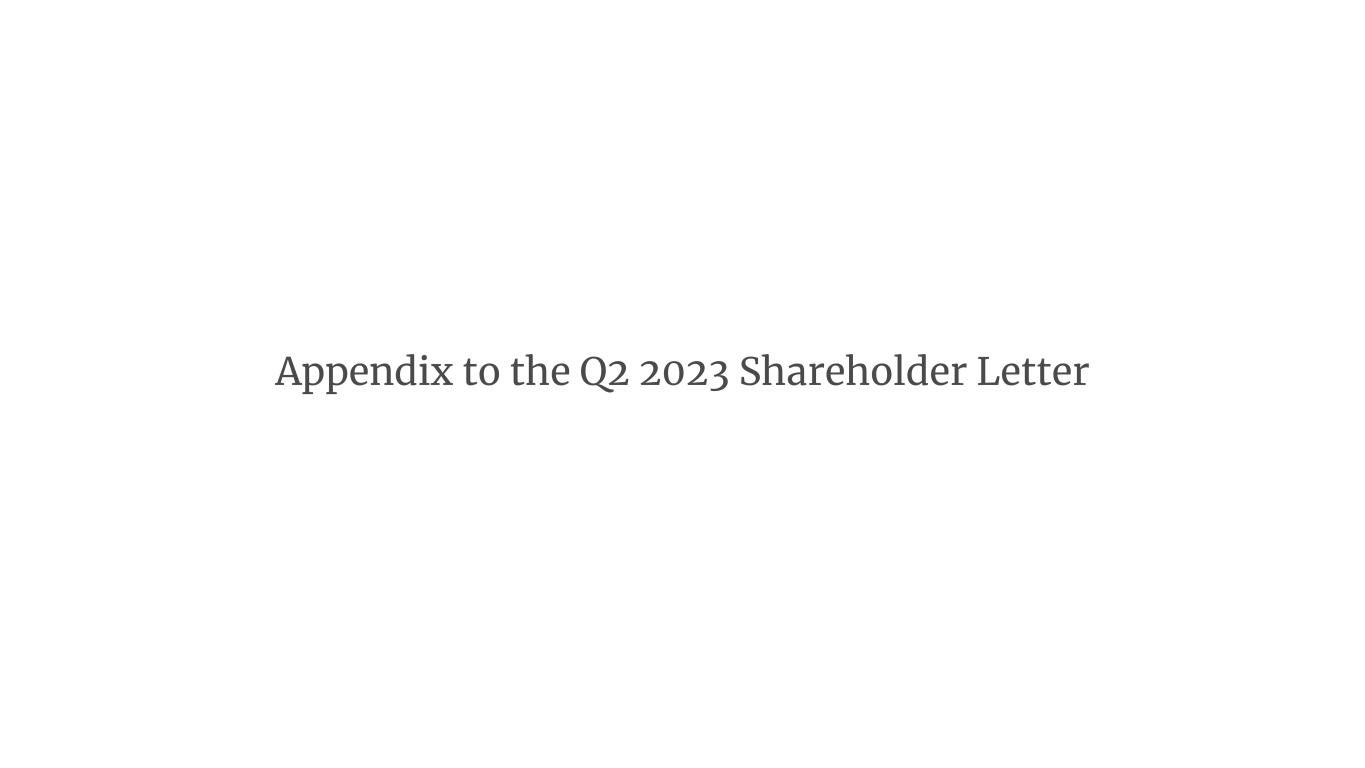
Appendix to the Q2 2023 Shareholder Letter

Customers (in ‘000s) In Force Premium ($s in m) 21% 31% YoY growth 50%54% 1,206 1,580 1,906 Q2 21 Q2 22 Q2 23 $296.8 $457.6 $686.6 Q2 21 Q2 22 Q2 23 $246 $290 $360 Q2 21 Q2 22 Q2 23 Premium Per Customer 24% 18% * = Appendix p.2
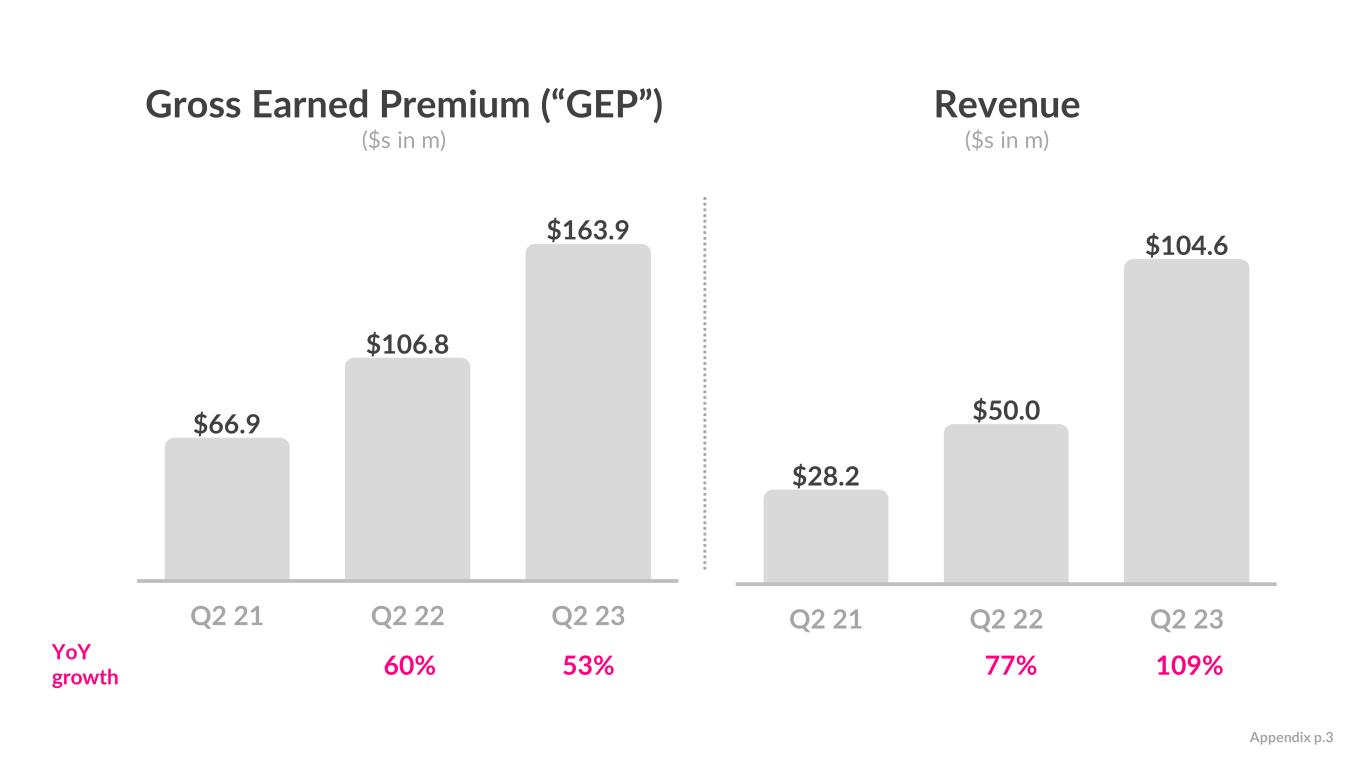
Gross Earned Premium (“GEP”) ($s in m) Revenue ($s in m) $28.2 $50.0 $104.6 Q2 21 Q2 22 Q2 23 109%77%YoY growth $66.9 $106.8 $163.9 Q2 21 Q2 22 Q2 23 53% 60% Appendix p.3
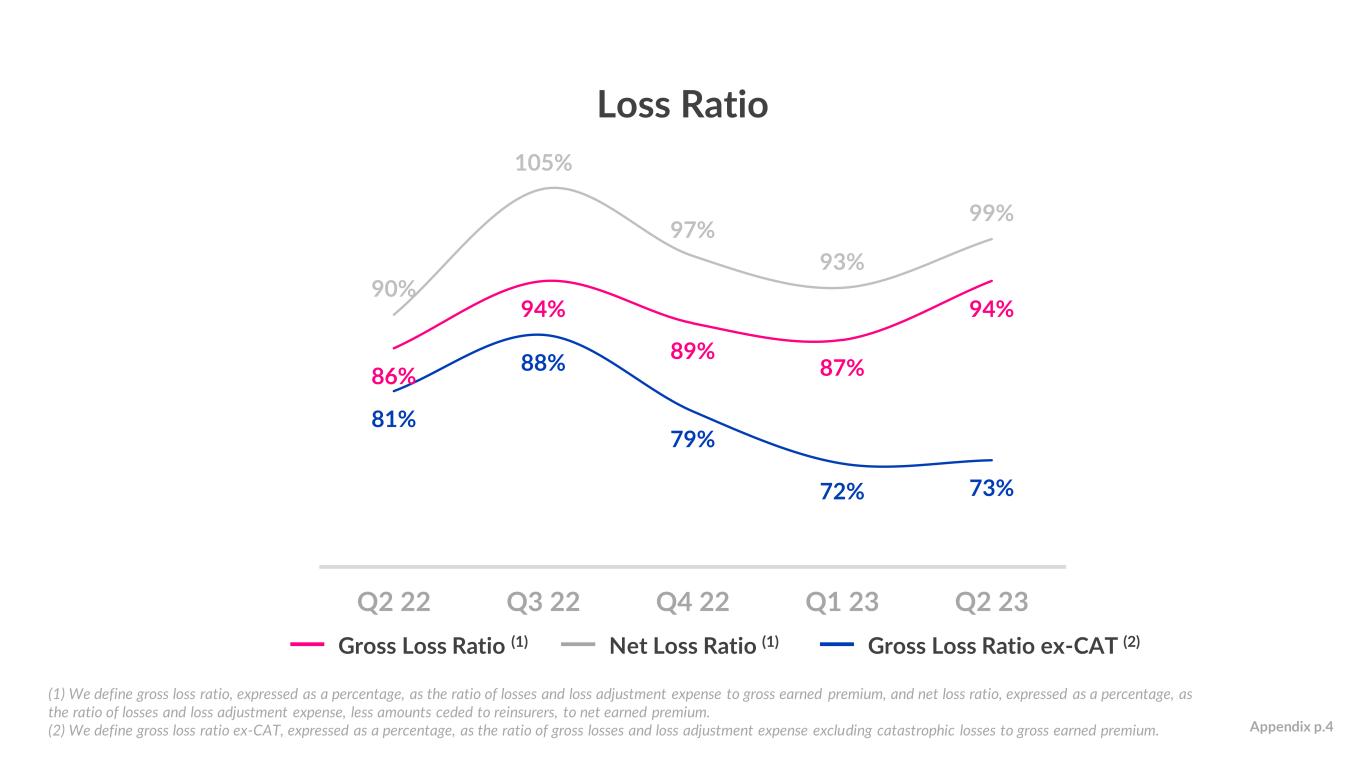
Loss Ratio Gross Loss Ratio (1) Net Loss Ratio (1) (1) We define gross loss ratio, expressed as a percentage, as the ratio of losses and loss adjustment expense to gross earned premium, and net loss ratio, expressed as a percentage, as the ratio of losses and loss adjustment expense, less amounts ceded to reinsurers, to net earned premium. (2) We define gross loss ratio ex-CAT, expressed as a percentage, as the ratio of gross losses and loss adjustment expense excluding catastrophic losses to gross earned premium. Appendix p.4 86% 94% 89% 87% 94% 90% 105% 97% 93% 99% 81% 88% 79% 72% 73% Q2 22 Q3 22 Q4 22 Q1 23 Q2 23 Gross Loss Ratio ex-CAT (2)
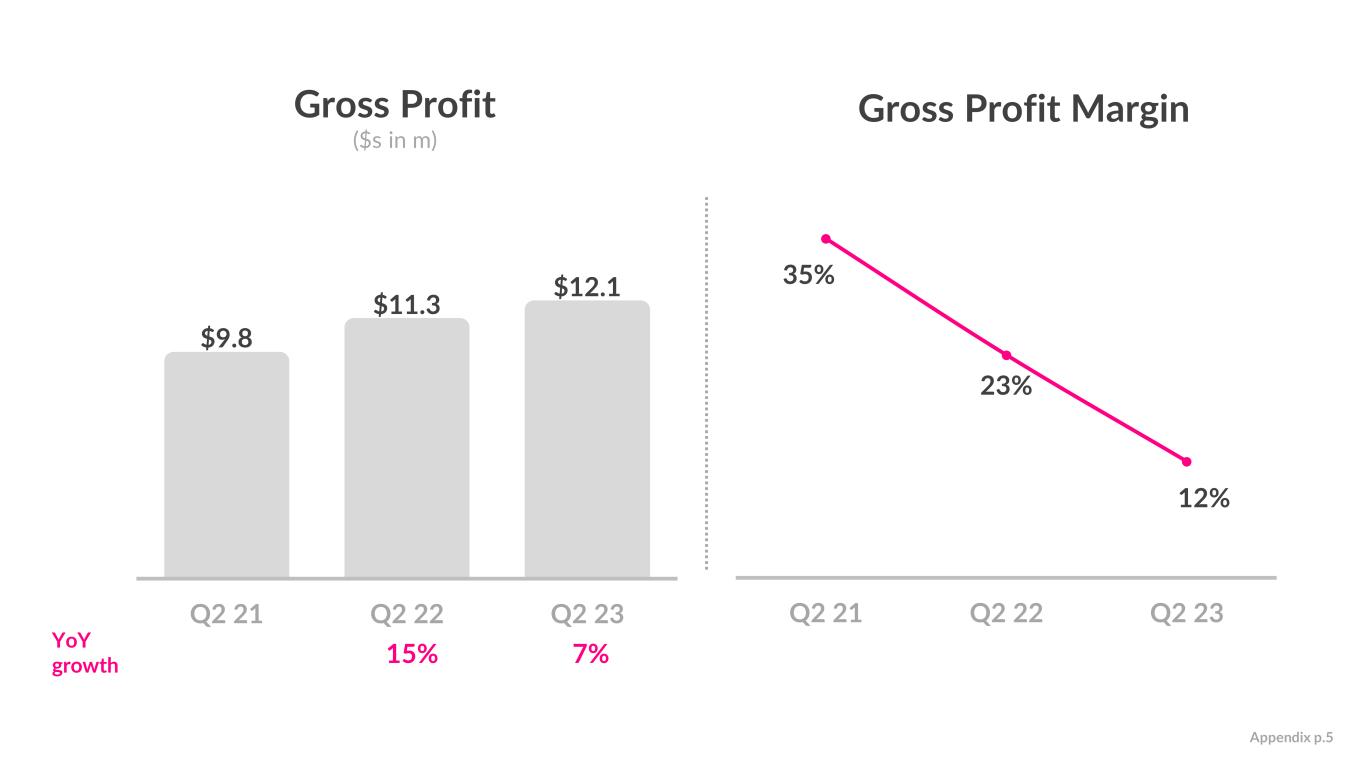
Gross Profit ($s in m) Gross Profit Margin 7%15% 35% 23% 12% Q2 21 Q2 22 Q2 23 YoY growth Appendix p.5 $9.8 $11.3 $12.1 Q2 21 Q2 22 Q2 23
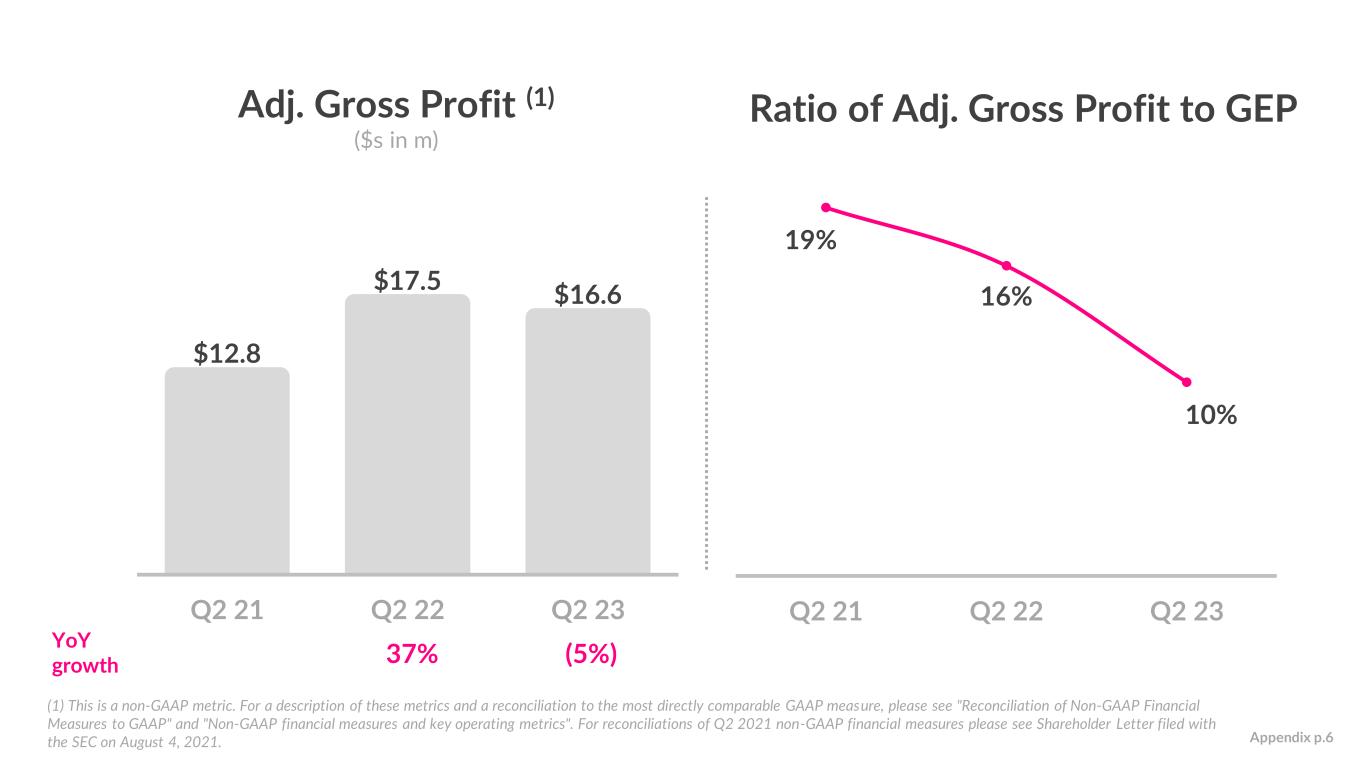
Adj. Gross Profit (1) ($s in m) Ratio of Adj. Gross Profit to GEP $12.8 $17.5 $16.6 Q2 21 Q2 22 Q2 23 (5%)37% (1) This is a non-GAAP metric. For a description of these metrics and a reconciliation to the most directly comparable GAAP measure, please see "Reconciliation of Non-GAAP Financial Measures to GAAP" and "Non-GAAP financial measures and key operating metrics". For reconciliations of Q2 2021 non-GAAP financial measures please see Shareholder Letter filed with the SEC on August 4, 2021. 19% 16% 10% Q2 21 Q2 22 Q2 23 YoY growth Appendix p.6
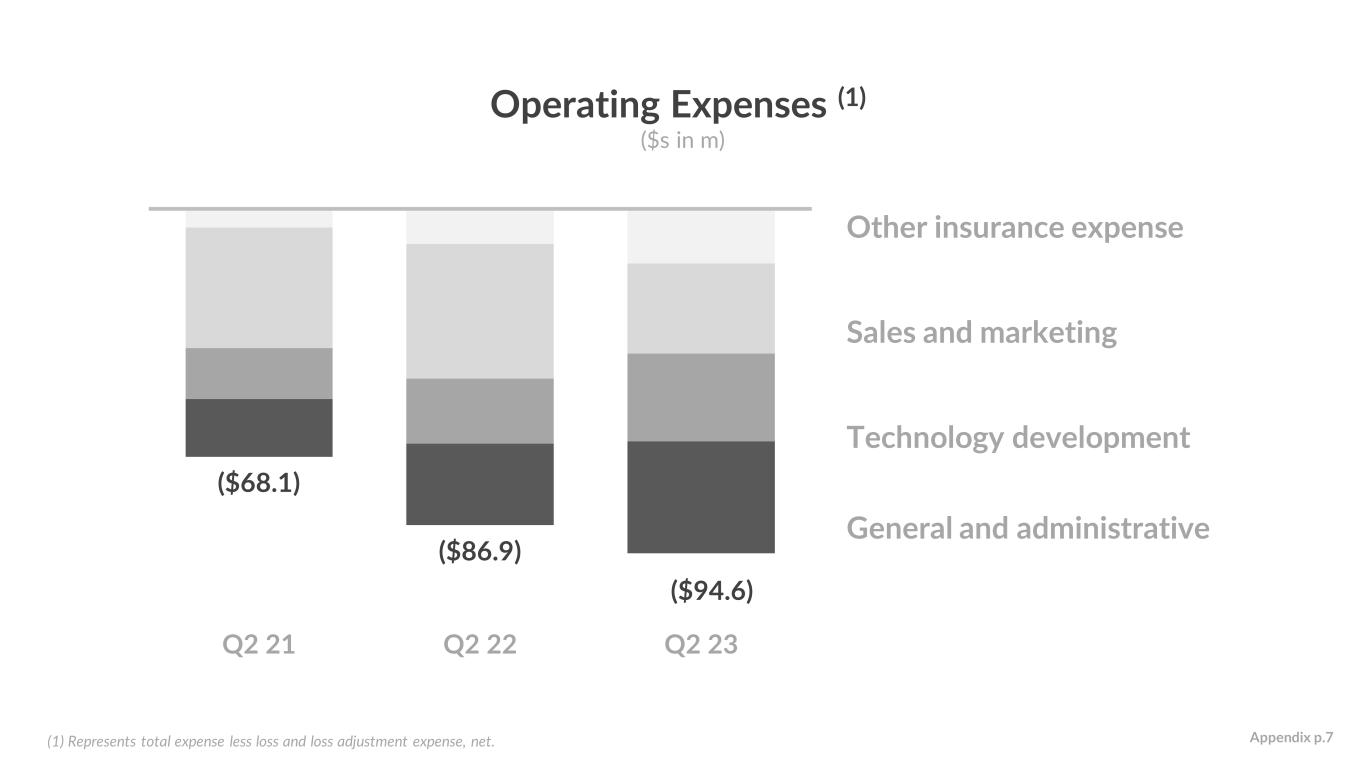
($68.1) ($86.9) ($94.6) Q2 21 Q2 22 Q2 23 Other insurance expense Sales and marketing Technology development General and administrative Operating Expenses (1) ($s in m) (1) Represents total expense less loss and loss adjustment expense, net. Appendix p.7
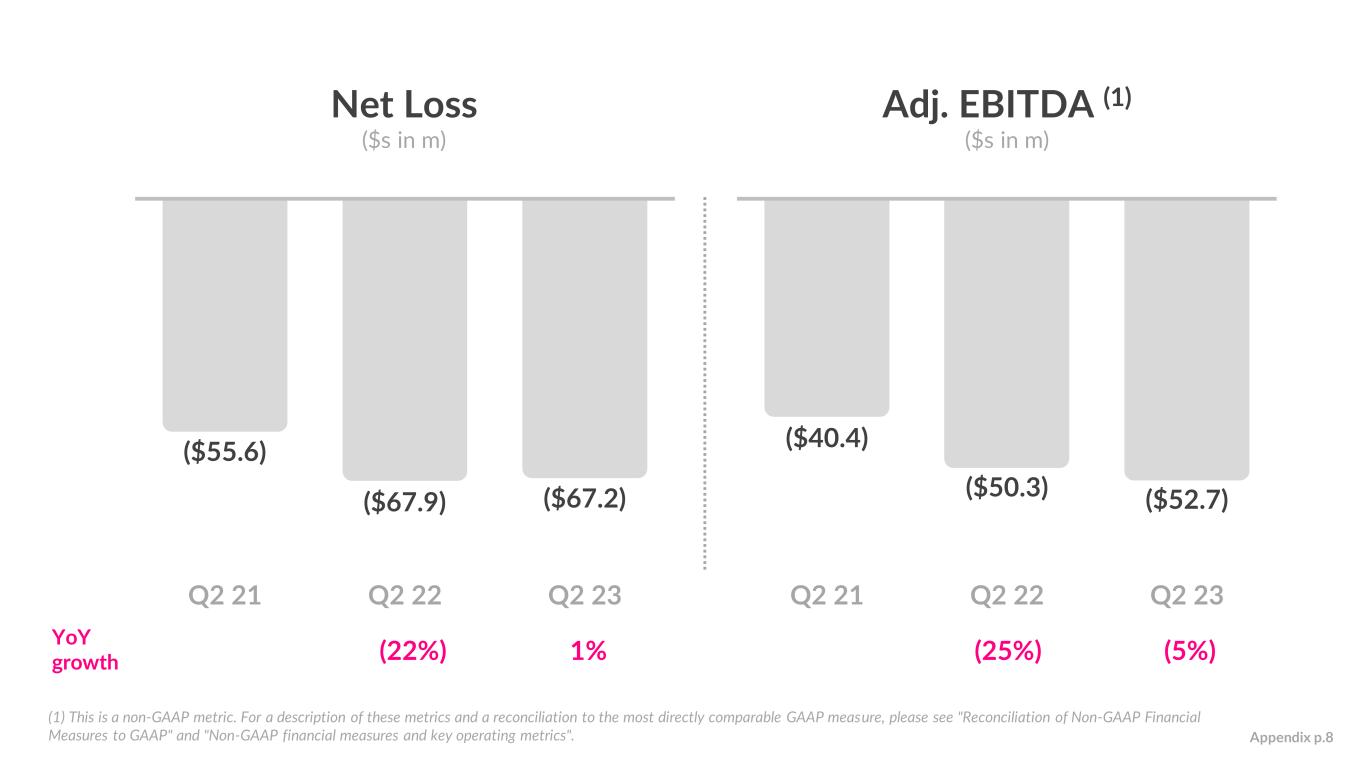
Net Loss ($s in m) Adj. EBITDA (1) ($s in m) (5%)(25%) YoY growth 1% (22%) (1) This is a non-GAAP metric. For a description of these metrics and a reconciliation to the most directly comparable GAAP measure, please see "Reconciliation of Non-GAAP Financial Measures to GAAP" and "Non-GAAP financial measures and key operating metrics". Appendix p.8 ($55.6) ($67.9) ($67.2) Q2 21 Q2 22 Q2 23 ($40.4) ($50.3) ($52.7) Q2 21 Q2 22 Q2 23
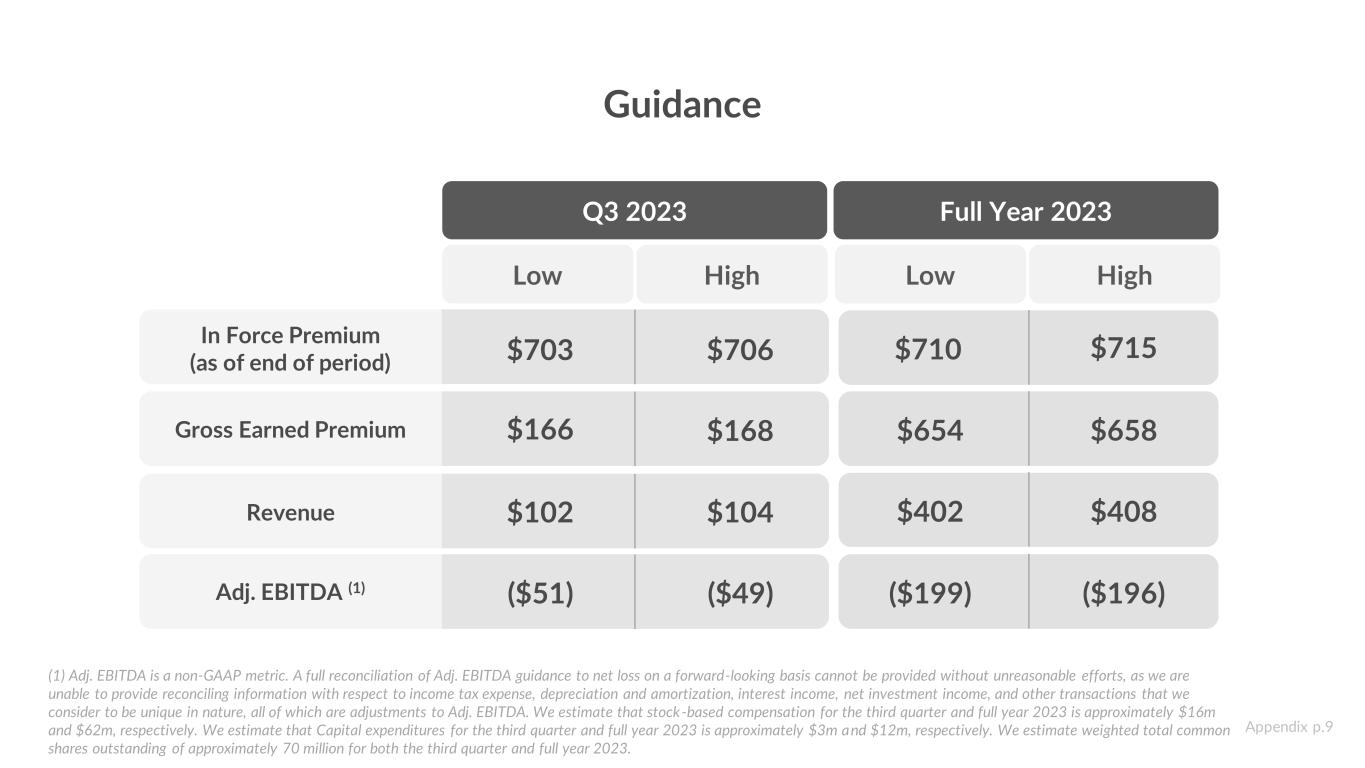
Guidance ($s in m) Q3 2023 Full Year 2023 $703 $706 $166 $168 $102 $104 ($51) ($49) ($199) ($196) $402 $408 $654 $658 $710 $715 Low High Low High In Force Premium (as of end of period) Gross Earned Premium Revenue Adj. EBITDA (1) (1) Adj. EBITDA is a non-GAAP metric. A full reconciliation of Adj. EBITDA guidance to net loss on a forward-looking basis cannot be provided without unreasonable efforts, as we are unable to provide reconciling information with respect to income tax expense, depreciation and amortization, interest income, net investment income, and other transactions that we consider to be unique in nature, all of which are adjustments to Adj. EBITDA. We estimate that stock-based compensation for the third quarter and full year 2023 is approximately $16m and $62m, respectively. We estimate that Capital expenditures for the third quarter and full year 2023 is approximately $3m and $12m, respectively. We estimate weighted total common shares outstanding of approximately 70 million for both the third quarter and full year 2023. Appendix p.9